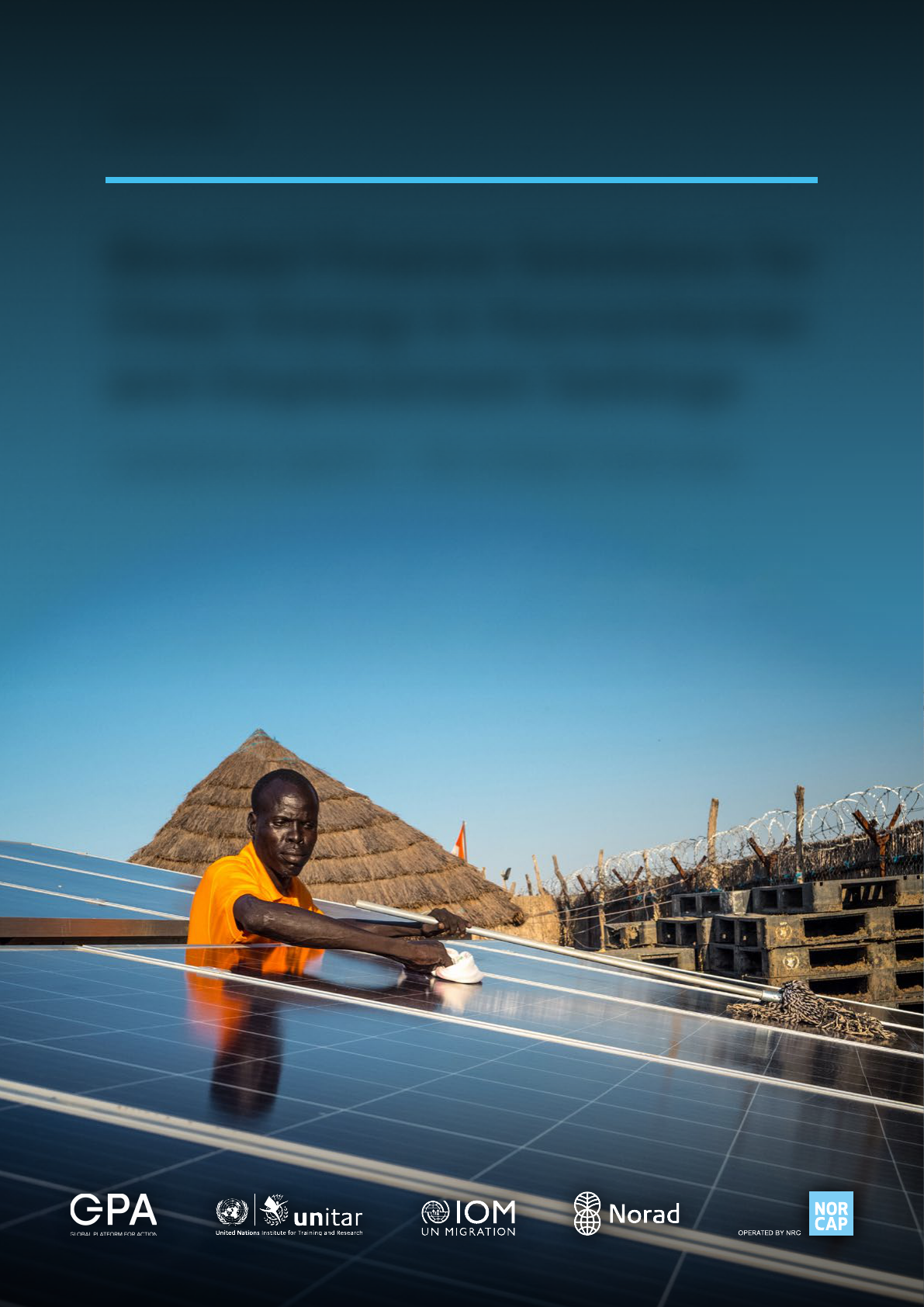
Blended Finance Solutions for
Clean Energy in Humanitarian
and Displacement Settings
Lessons Learnt – An Initial Overview
January 2022

Acronyms
BMZ German Federal Ministry of Economic Cooperation and Development
DESCO Distributed energy service companies
DIB Development Impact Bond
EDM Energy Delivery Models
ESDS Energy Solutions for Displacement Settings
EU European Union
GCR Global Compact for Refugees
GPA Global Platform for Action on Sustainable Energy in Displacement Settings
HIB Humanitarian Impact Bond
IB Impact Bond
ICRC International Committee of the Red Cross
IDP Internally Displaced Persons
IOM International Organisation for Migration
KKCF Kakuma Kalobeyei Challenge Fund
LPG Liquied Petroleum Gas
MRV Measuring, reporting and verication
NORAD The Norwegian Agency for Development Cooperation
NRC Norwegian Refugee Council
OECD Organisation for Economic Co-operation and Development
PA Practical Action
PAYG Pay-As-You-Go
RBF Results Based Financing
RE4R Renewable Energy for Refugees
SDG Sustainable Development Goal
SEED Soutien Energétique et Environnemental dans la région de Diffa
SER Staff Eciency Ratio
SHS Solar Home System
SIB Social Impact Bond
Sida Swedish International Development Cooperation Agency
SNV (Netherlands) Foundation of Netherlands Volunteers
UN United Nations
UNHCR United Nations High Commissioner for Refugees
WEF World Economic Forum
WFP World Food Programme
1. Introduction
05
2. Funding challenges for energy
programming in displacement settings
06
3. Blended nance
08
3.1.
3.2.
3.3.
3.4.
3.5.
3.6.
3.7.
What is blended nance?
What is the role of blended nance?
Why is blended nance relevant to humanitarian energy programming?
What does blended nance look like?
When and how to use blended nance solutions
Blended nance, subsidies and policy reform
Supporting mechanisms
4. Blended nance solutions for energy
programming in displacement settings
11
4.1.
4.2.
4.3.
4.4.
4.5.
Direct funding for the removal of commercial barriers
Technical assistance
Risk transfer mechanisms
Market incentives
Using more than one blended nancing mechanism
5. Conclusions, recommendations and next
steps
32
5.1.
5.2.
Conclusions
Recommendations
Works cited and consulted
36
Authors and acknowledgements
39
Contents
Cover Photo: The local volunteer Michael Gatluak clean the new solar panels at the
NRC oce in Mankien – South Sudan. Photo: NORCAP / Iban Colón
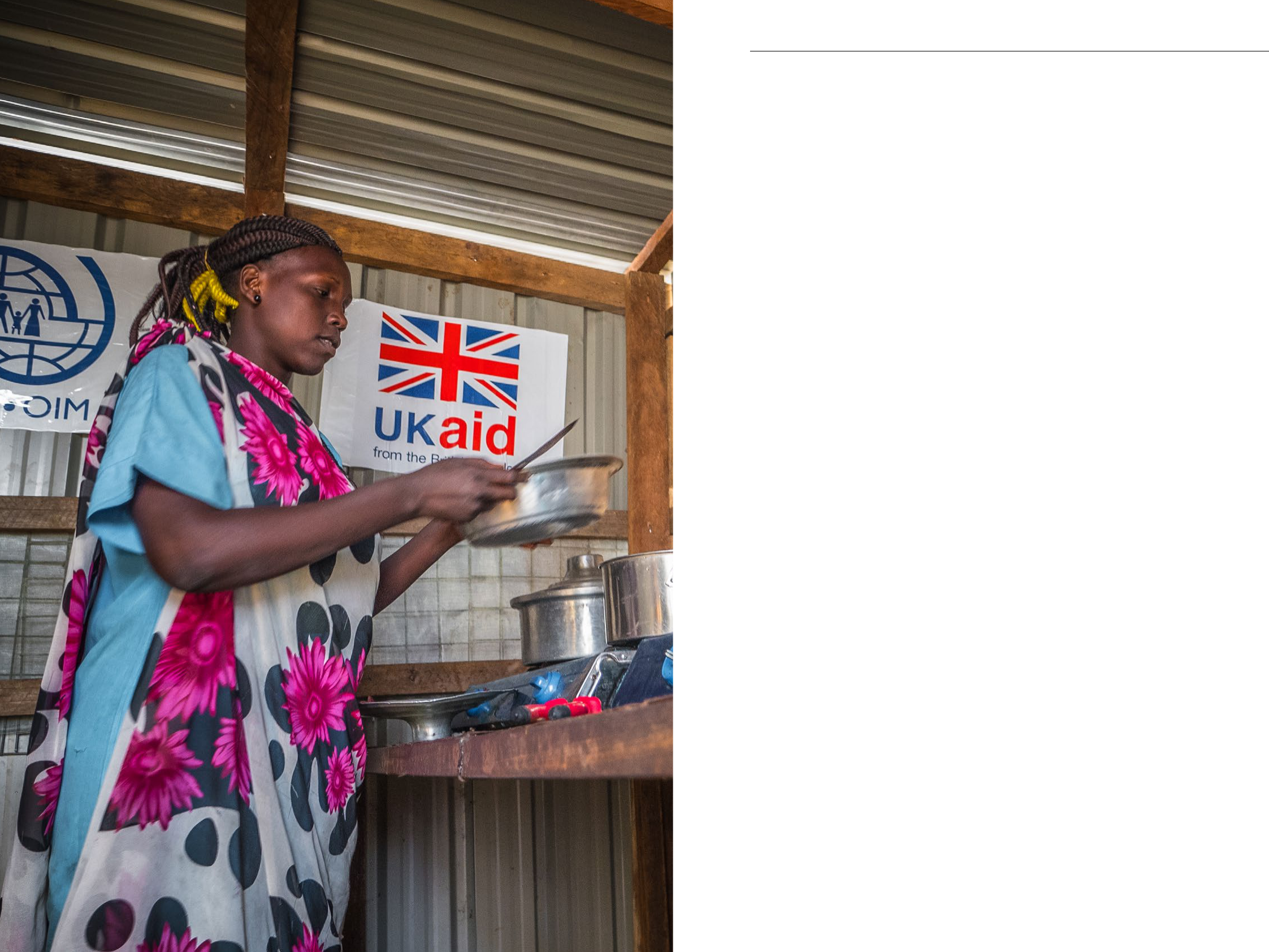
05
1. Introduction
04
Currently, over 235 million people require humanitarian assistance (UN OCHA,
2021). Of these, 91.9 million people have been recorded as displaced as a result of
persecution, conict, violence, human rights violations or events seriously disturbing
public order (UNHCR, 2021).
Energy is recognised as an enabler of basic human rights, however, a majority of
displaced populations still lack sucient access to clean, sustainable, reliable,
appropriate and affordable energy (GPA, 2021). According to estimates, 80 per cent
of refugees and displaced people in camps have minimal access to energy, with high
dependence on traditional biomass for cooking and no access to electricity (Lahn and
Grafham, 2015).
Limited access to energy can have severe repercussions on the health, safety and
security of displaced populations and limits their opportunities to learn, become
self-reliant and socialise with peers. Additionally, where the energy needs of the
displaced community are being met, the nancial and environmental costs tend to
be high because of poor practices, inecient appliances, high fuel costs and limited
monitoring of energy consumption. Furthermore, diesel-powered generators are one
of the most prevalent energy solutions for humanitarian operations due to the off-
grid location of the response or their connection to grids that suffer from brownouts
(drop in voltage) or blackouts. Although humanitarian organisations recognise their
moral and nancial obligation to ‘green’ their operations to minimise their climate and
environmental footprint, it is an economic challenge to do so even when the transition
to renewable sources of energy offers an opportunity to save money over the medium
to long term.
Unfortunately, traditional grant-based funding, which humanitarian organisations rely
on, is not sucient to deliver the energy needs of the displaced (household cooking,
household access to electricity, energy at service centres, such as health clinics and
schools, and for livelihood opportunities) or to support the required institutional energy
transition (see Chapter 2). In addition, due to its limitations, grant funding rarely results
in self-sustaining energy solutions. Also, grant funding is not readily accessible to
humanitarian actors to support their transition to more sustainable energy solutions.
As such, if humanitarian actors were to rely on grant funding, it is unlikely that SDG7
(ensure access to affordable, reliable, sustainable and modern energy) will be achieved
in displacement settings. Blended nance may, however, be part of the solution to
bridging the funding gap and drive self-sustaining solutions in displacement settings
by accessing nancing from the private sector.
This report aims to provide an overview of blended nance mechanisms, their role
in delivering sustainable energy solutions as part of the humanitarian response,
highlighting key lessons learnt from their use in displacement settings and making
recommendations for their continued development.
1. Introduction
Woman cooking in the communal kitchen
of the Biogas plant at the POC (Protection
of Civilians Site) of Malakal – South Sudan.
Photo: NORCAP / Iban Colón

Blended Finance Solutions for Clean Energy in Humanitarian and Displacement Settings
0706
2. Funding challenges for energy programming in displacement settings
DELIVERING SUSTAINABLE SOLUTIONS AMIDST
SHORT-TERM BUDGET CYCLES
Traditionally, humanitarian actors have delivered energy
access solutions in displacement settings through free
distributions of goods and services funded by grants
from a variety of donors. Such approaches, however, do
not result in sustainable solutions, as the provision of
the goods and services usually cease once the grant
funds have been spent. In addition, the scalability of
most energy access projects is limited by the donors’
contributions and ongoing interest in the energy topic,
geographic location, humanitarian emergency or
protracted situation. This is further compounded by the
problem posed by annual budget cycles, which make
it almost impossible for the humanitarian sector to
implement energy projects, which can take up to ve
years, from the initial planning stage, to complete.
Furthermore, grant funding for decarbonising the
humanitarian response (e.g. transitioning from diesel-
based energy systems to solar solutions) or providing
electricity access to a displacement setting provides
additional challenges to traditional donors. For instance,
many donors offer core funding to humanitarian actors
and expect the grant to be used in the most resource-
ecient manner. Therefore, if solar solutions are more
cost-ecient than existing diesel-based systems, the
donor expects the humanitarian actor to transition to
the cheaper solution with the core funding it already
receives.
ADDITIONALITY OF ENERGY PROGRAMMING
Energy access programmes can, however, create
positive long-term effects that outweigh the original
project funds spent. For instance, it has been
calculated that every dollar spent on increased energy
access results in a return on investment to the value
of 1.40 USD to 1.70 USD from employment, improved
health, productivity, and time-saving.(Shell, Dalberg
& Vivid Economics, 2020). In addition, added benets
of displaced populations accessing clean energy can
also lead to higher education rates, reduced protection
risks, reduced environmental impact and access
to information through smart technology, including
phones and the internet, helping individuals make more
informed choices.
WHOSE ROLE IS IT; HUMANITARIAN OR
DEVELOPMENT ACTORS?
When traditional donors provide grants to humanitarian
organisations, they typically seek results with a direct
humanitarian impact and, as such, often view energy
projects, especially those that increase access to
electricity, as ‘development’ initiatives as the projects
tend to stretch over an extended time period and
results in long-term energy access solutions. The
energy or development colleagues of traditional
humanitarian donors, however, feel that providing
energy infrastructure in displacement settings should
be funded by their humanitarian counterparts, given the
context and the ‘temporary’ nature of the displacement.
Hence, we end up in a situation where donors see the
value in supporting energy projects but feel unable to
provide the necessary funding.
FINANCIAL CONTROLS AND LIMITATIONS ON
PROCUREMENT MODALITIES
Many humanitarian partners, especially those within
the UN system, have very restrictive nancial rules and
regulations which limit their ability to experiment with
new nancing strategies. For example, they are unable
to take loans or benet from any nancial mechanisms
that could be construed as a loan. Furthermore,
humanitarian partners have limited experience with
new procurement modalities such as “energy-as-a-
service” or energy asset leasing models, which limit
this potential avenue of private sector engagement and
nancing the delivery of sustainable solutions.
HUMANITARIAN RESPONSE IS UNDERFUNDED
Although we are at an all-time peak in terms of the
number of people in need of humanitarian assistance,
global funding for the humanitarian response has
plateaued, resulting in an unparalleled funding gap of
52 per cent (Chatham House, 2021). More specically,
current spending on cooking and power in displacement
2. Funding challenges for energy
programming in displacement
settings
settings has been estimated to be around 1.6 billion
USD. By 2030 future spending could be as high as 5.3
billion USD (Shell, Dalberg & Vivid Economics, 2020).
How will humanitarian organisations address this
future nancial need when they are already struggling
to meet today’s nancial demands?
CHALLENGING COMMERCIAL ENVIRONMENT
The acknowledgement of such shortfalls with
traditional grant-based solutions has resulted in the
promotion of market-based approaches where the
provision of energy services in displacement settings
are delivered by the private sector, with assistance from
humanitarian and/or government actors. In addition,
the private sector is showing an increased interest in
commercial opportunities to deliver energy access
for cooking (cookstoves and/or fuel) and electricity
(solar home systems and mini-grids) to the ‘bottom of
the pyramid’ and ‘last mile’ end-users. Many displaced
communities fall under such classication.
Commercial environments within refugee or migrant
camps are, however, subject to a unique set of rules and
regulations, which can be dicult for non-humanitarian
actors to navigate. In addition, there is a clash of
cultures. While humanitarian actors are focused on
providing protection to the displaced, the majority of
private sector actors a seeking commercially viable
business models, even if they have a strong stance
towards social responsibility. Overcoming this clash
can be problematic because the two entities speak
different ‘languages’ and have very different operational
risk proles. Furthermore, the lack of integration
of displaced populations into national strategies
perpetuates dependence on humanitarian aid. As such,
policies and the supporting ecosystem (e.g., recognition
of registration documents, right to work, cash-based
interventions, access to bank accounts, mobile money,
etc.) can be unfavourable for private sector investment
and associated delivery models.
Given the perceived ‘temporary’ nature of such settings
and the assumed lack of commercial opportunity
within displaced communities, the private sector is
cautious in its approach to delivering energy services
to the displaced. Refugee settlements, however, have
an average lifespan of 18 years (Haselip; 2022), and in
protracted situations, there is a demand for commercial
energy solutions. For instance, 53% of surveyed
refugees in Tanzania purchased their cooking fuel,
spending on average 12 USD a month per family, which
is approximately three times the national average. Of
those surveyed, 95% expressed a willingness to pay for
Liquied Petroleum Gas (LPG) as a cooking fuel (Rivoal
and Haselip, 2018).
Although such commercial opportunities exist, the
range of risks and uncertainties for commercial
entities and investors remain, especially with regards to
affordability of potential solutions. As such, traditional
approaches to nancing energy programmes cannot
be supported by the risk-return characteristics of
displacement settings. Therefore, alternative nancial
mechanisms are required and hence the interest in
innovative nance solutions for energy programmes in
the humanitarian sector.
Innovative nancing to replace grant funding
There is no agreed denition of ‘innovative nancing.’
It is understood that relevant stakeholders consider
innovative nancing to encompass one or more of the
following:
● Is everything that is not direct, traditional grant
funding;
● The generation of additional money from non-
traditional sources;
● Combining funds from multiple sources to
accomplish one nancing objective;
● Increasing the effective use of existing nancial
resources, including money received from
traditional humanitarian donors, i.e., achieving
more impact with the same amount of money;
● A nance mechanism that is new in the
humanitarian system or one in which there is little
experience; and/or
● Creating platforms which connect providers of
capital/funds with borrowers.
It is important to note that many innovative nance
solutions are designed in a way in which end users
(displaced people) - at least partially - pay for goods
or services. As such, it comes as no surprise that
innovative nance solutions remain underdeveloped in
the humanitarian system.
One type of innovative nancing is blended nancing. A
denition for blended nancing, an overview of blended
nance mechanisms, their role in delivering sustainable
energy solutions as part of the humanitarian response
is outlined in the remainder of this report, which
concludes with recommendations for their further
development.
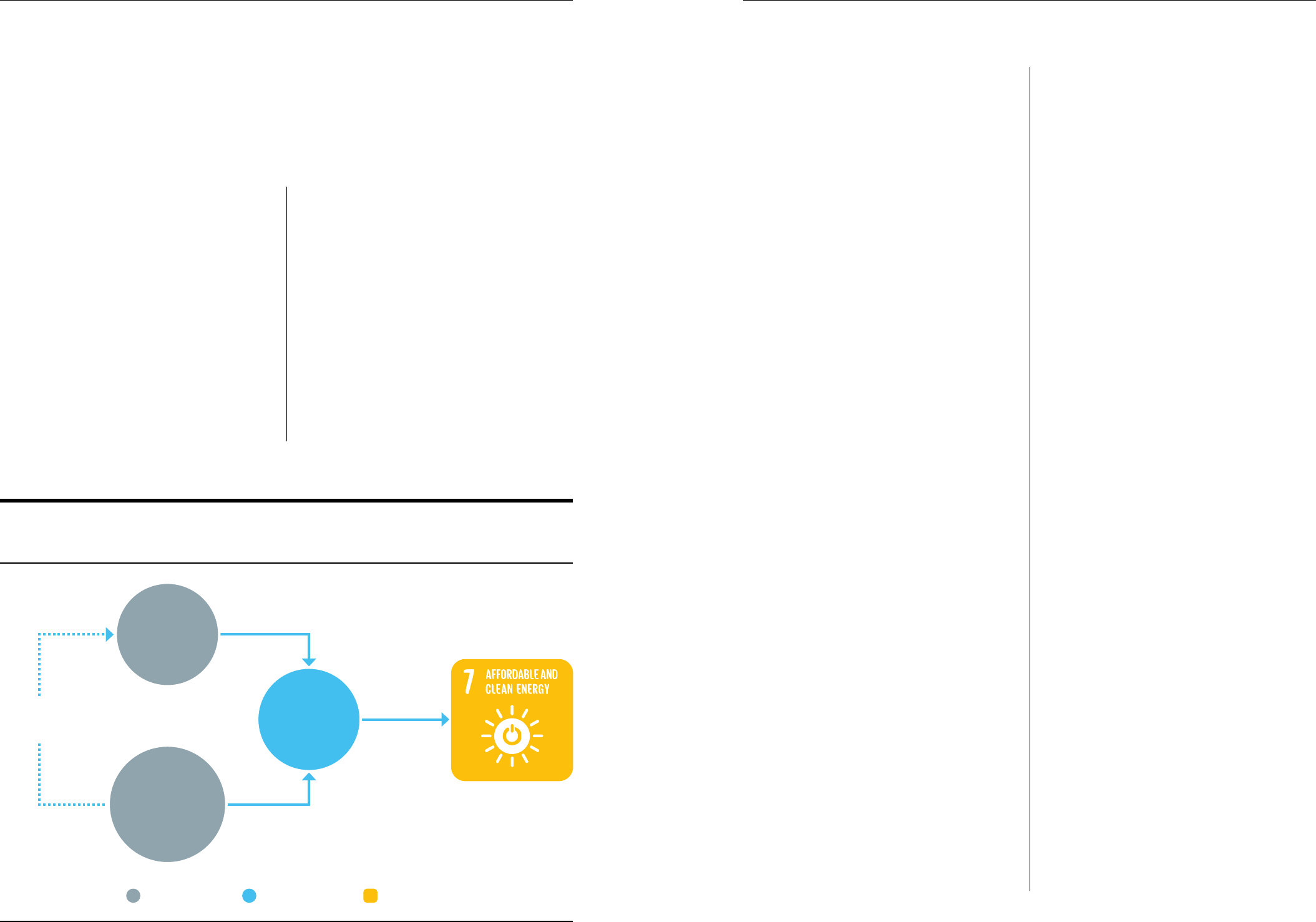
Blended Finance Solutions for Clean Energy in Humanitarian and Displacement Settings
0908
3. Blended nance
3.1. What is blended nance?
Blended nance is dened as an approach for
increasing the amount of project funding by combining
different types of nancing from different sources
and/or for different purposes, which contribute to
development, social, environmental or humanitarian
goals and generate nancial returns. It is common
for one source of funding within the blended nance
solution to act as a catalyst for raising additional
funds.
In essence, blended nance is a mechanism that
allows organisations with different objectives to
‘invest’ alongside each other while achieving their own
objectives (International Bank for Reconstruction and
Development & World Bank, 2020).
There are three key characteristics associated with
blended nance, which are:
● Leverage: Use of humanitarian or development
nance and philanthropic funds to attract
commercial nance into projects.
● Impact: Investments that drive development,
social, environmental or humanitarian progress.
● Returns: Financial returns for private investors in
line with market expectations, based on real and
perceived risks (WEF & OECD, 2015).
Figure 1 provides a pictorial overview of blended
nance with regards to delivering SDG7 in displacement
settings.
3. Blended nance
3.2. What is the role of blended
nance?
The role of blended nance is to increase returns and/or
lower risks for a commercial entity, which in turn allows
it to mobilise private capital to develop markets it would
not normally enter (WEF & BSG, 2019). In providing an
improved risk-return proposition for the private sector,
blended nance can help bridge funding gaps as the
private sector invests its own money into the solution.
At present there is no estimate on the investment
potential of the private sector for energy projects in
displacement settings. It has, however, been noted that
the impact investment market, who tolerate higher risks
and below-market returns to generate positive social
and environmental impacts, equated to approximately
$715 billion at the end of 2019 (WEF, 2021).
3.3. Why is blended nance
relevant to humanitarian energy
programming?
Blended nance was rst considered as a tool to ll the
funding gap associated with delivering the Sustainable
Development Goals (SDGs), as most of the nance
ow was through intergovernmental mechanisms,
multilateral grants and bilateral cooperation, which was
not enough to achieve the SDGs (United Nations, 2021).
Blended nance is, therefore, seen as a mechanism
to mobilise private sector investment to support the
delivery of the SDGs.
The rationale behind blended nance is to support
projects with potentially high social benets, which
would not obtain traditionally funding on commercial
terms due to the perceived high risk of operating in
such contexts (WEF & OECD, 2015). Humanitarian
actors are therefore interested in blended nance due
to its ability to mobilise private sector investment in
delivering long-term, sustainable solutions in what are
perceived to be high-risk settings while addressing their
own funding gap.
With respect to energy programming in displacement
situations, blended nance is a mechanism that can
leverage the mobilisation of private capital through
grant funding, which, when combined, can deliver
sustainable energy solutions in emerging or frontier
markets that exist in and around many displacement
settings.
3.4. What does blended nance
look like?
As outlined by the Organisation for Economic Co-
operation and Development (OECD) and the World
Economic Forum (WEF), blended nance can include
one or more of the following nancial support
mechanisms:
1. Direct funding for the removal of commercial
barriers;
2. Technical assistance;
3. Risk transfer mechanisms; and/or
4. Market incentives.
A summary of each mechanism in presented in Table
1 and an overview of each, including examples from
humanitarian energy programming, is provided in
Chapter 4.
No one blended nance solution, however, will t all
situations. Therefore, the structure of a particular
blended nance instrument must be specic to the
aims, nancial needs, delivery model, and risk prole
of the programme it aims to support (Cohen & Patel,
2019).
3.5. When and how to use blended
nance solutions
Blended nance should only be used in situations where a
market failure prevents traditional market development
by the private sector, which results in humanitarian,
development, social and/or environmental impacts that
outweighs the expected nancial returns of the private
investors supporting project. It is, therefore, crucial that
the nancial package offered to the private sector is
not greater than that deemed necessary to induce the
intended investment. This approach is referred to as
the minimum concessionality principle (OECD, 2020
1
).
To assess whether blended nance is needed and
how it can be effectively structured, it is essential to
understand the restrictions and market failures and
the sectoral, country and humanitarian context, and
to articulate how blended nance is supporting the
creation of markets or is helping them move toward
commercial sustainability (IFC, 2018). As a result, it
is important to ensure the blended nance solution is
Figure 1: Overview of Blended Finance in Delivering SDG7
Adapted from OECD 2020
Financing sources Financing structure Use of nance
Mobilising /
Catalysing
In Displacement Settings
Non-concessional
Concessional /
Non-concessional
Humanitarian /
Development/
Philantropic
Finance
Commercial
Finance
Blended
Finance
Transactions /
Approaches
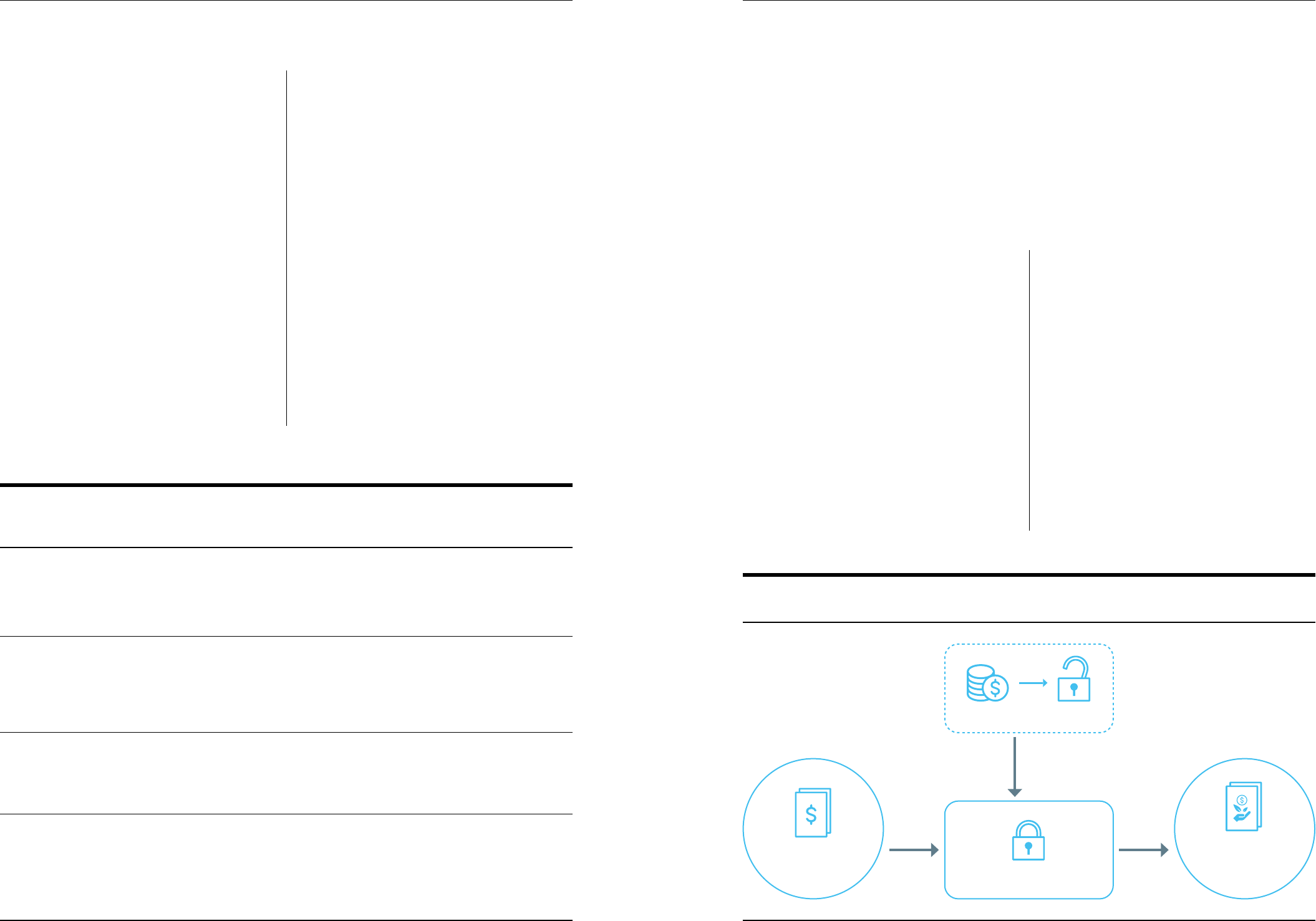
Blended Finance Solutions for Clean Energy in Humanitarian and Displacement Settings
1110
4. Blended nance solutions for energy programming in displacement settings
Table 1: Summary of Blended Finance Mechanisms
Adapted from WEF 2015
Direct funding for the
removal of commercial
barriers
Direct funding is provided to unlock a barrier that is preventing an otherwise
commercially viable project from commencing. Direct funding is in effect a grant but
unlike traditional grants the aim of the one-off donation is to create a commercially
sustainable business by removing an identied market barrier.
Technical assistance Technical assistance addresses risks in new, uncertain and fragmented markets
for investors. Costs and risks associated with exposure to new markets, technical
uncertainty, and the inability to build a pipeline can be reduced, lowering the high
transaction costs for investors and reducing operational risks which often dissuade
a commitment of funds.
Risk transfer
mechanisms
Risk transfer reduces specic risks associated with a transaction. This mechanism
provides direct compensation or assumes losses for specic negative events,
addressing the concern of private capital providers to ensure their capital can be
preserved related to project/company specic risks.
Market incentives Market incentives address critical sectors that do not support market fundamentals.
This helps new and distressed markets that require either scale to be commercially
viable or reduced volatility, by providing xed pricing for products in order for private
capital to justify committing to the sector.
designed to meet the identied challenge or challenges
and does not provide nancial support to commercial
risks that can be addressed by the private sector alone.
It is also noted that blended nance should only be used
to address temporary challenges in the marketplace.
For instance, where an initial push to provide a ‘safe’
operating space is required, from which the private
sector can build a self-sustaining commercial presence
that requires no additional concessional funds.
3.6. Blended nance, subsidies
and policy reform
A subsidy is dened as a direct or indirect payment
to individuals or commercial entities that remove a
‘problem’ to promote a social good or an economic
policy. In economic terms, a subsidy is used to offset
market failures and externalities in order to achieve
greater economic eciency (Investopedia, 2021). As
such, it can be argued that blended nance is a form
of subsidy.
Financing on commercial terms should, however, always
be the preferred option to avoid distorting markets
or creating private sector dependence on subsidies.
Blended nance is, therefore, not the solution to long-
term structural issues where permanent subsidies are
called for. Nor is it the solution for inadequate policies
where policy reforms are required (IFC, 2018).
3.7. Supporting mechanisms
Climate funds and carbon nancing can be used to
support blended nance initiatives in humanitarian
situations. In addition, cash-based interventions,
end-user nance and payment systems can play an
important role in supporting the introduction of private
sector solutions to displacement settings. However,
they usually require a long-term approach that many
humanitarian operations cannot commit to. They are,
however, subject matters in their own right and, as
such, it is envisioned that these topics will be covered
by the Global Platform for Action on Sustainable Energy
in Displacement Settings (GPA) in future reports.
The following chapter provides an overview of the four
blended nance mechanisms noted in Section 3.4.
The overview includes a summary of the mechanism,
how it works, its pros and cons, its relevance to energy
programming in displacement settings, and examples
of relevant projects; highlighting lessons learnt.
4.1. Direct funding for the removal
of commercial barriers
4.1.1. What is it and how does it work?
Funding is provided by a donor to a project to unlock
a barrier that is preventing an otherwise commercially
viable project from starting. The direct funding is in
effect a grant, so does not have to be paid back, but
unlike traditional grants the aim of the one-off donation
is to create a commercially sustainable business by
removing the identied barrier, as noted in Figure 2.
Direct funding should only be used if there is a clearly
identiable barrier, which has been identied during the
baseline survey and is recognised as the main barrier to
an energy programme.
4.1.2. How can it be applied to
displacement settings?
Barriers to entry that are relevant to displacement
settings could include costs, amongst others,
associated with construction, logistics, technology,
appliances and import taxes for project infrastructure.
As an example, an energy service company could have
a commercially viable business to sell electricity to a
4. Blended nance solutions
for energy programming in
displacement settings
Commercially
Viable Project
Commercially
Sustainable
Business
Financial Barrier
Donor
Direct Funding
One-off donation unlocking an
identied nancial barrier
Figure 2: Overview of Direct Funding Mechanism
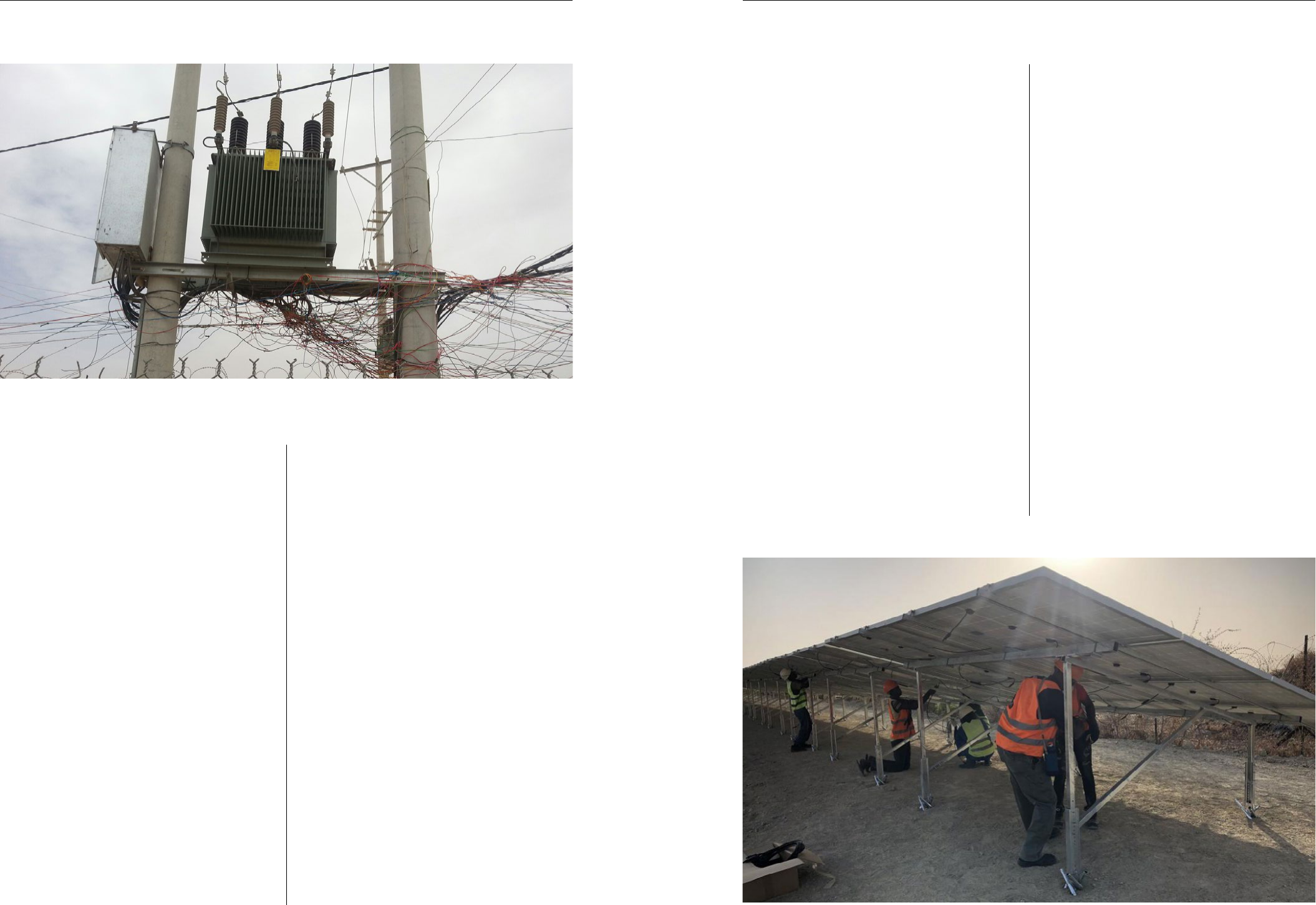
Blended Finance Solutions for Clean Energy in Humanitarian and Displacement Settings
1312
4. Blended nance solutions for energy programming in displacement settings
humanitarian actor from a solar plant that the energy
service company will own and operate. However, before
being able to use this electricity, the humanitarian
partner would need to invest in upgrading their electrical
wiring system. This project attribute is a nancial hurdle,
which - if incorporated into the business model – could
make the project more expensive than an existing
diesel-based solution, preventing the humanitarian
actor from transitioning to a cleaner source of energy. A
direct payment from a donor could, however, cover that
cost of the wiring upgrade and unlock a commercially
viable activity, that has development, humanitarian,
social and/or environmental benets. Other project
attributes associated to decarbonising activities that
could be supported by a one-off grant could include:
● Preliminary works associated with:
● Upgrading existing electrical cabling within the
building and the extension to the new solar
plant;
● Strengthening roong or foundations to
support the solar solution;
● Moving existing infrastructure to make space
for the solar solution; and/or
● Replacing existing equipment with more
energy-ecient solutions, such as energy
ecient appliances, air conditioning units,
lighting, etc., which in turn would reduce the
size of the solution and reduce costs.
● Moving and transporting high-value goods:
● Over long distances and through terrain, where
there is a signicant risk of goods becoming
damaged, and insurance is unavailable or too
expensive; or
● Through conict zones, where there is a
signicant risk of goods becoming damaged
or stolen as a result of an ambush.
● Technological solutions, such as battery storage
in areas where alternative emergency back-up
solutions are essential but not readily available,
e.g. diesel supply is sporadic and limited.
● Appliances, which once distributed, allow the
private sector to sell services, including electricity
and fuel, to the end-user.
● Taxes associated with importing project
infrastructure into a country, which only requires a
single payment.
Similarly, barriers to household cooking projects could
include the cost of a vehicle for distribution, a safe storage
compound for a fuel, the initial cost of an appropriate
cook stove, training technicians and users, etc.
Figure 3: Wiring from the main cables without protection. Photo copyright: UNHCR / Yanal Almadanat
4.1.3. Example project: Humanitarian Hub
in Malakal, South Sudan
The signicant capital investment costs of launching
new clean energy access projects in displacement
settings are often the most challenging hurdle and
can keep a project on hold until appropriate funding
is found. The sourcing of high-quality equipment and
technical expertise in remote areas, or the logistics
and delivery of materials through high-risk areas
(sometimes via helicopter or convoy), can signicantly
increase the capital needed. In some cases, these start-
up costs can be prohibitive.
One such example involved an energy transition project
at the Humanitarian Hub in Malakal, South Sudan,
which is managed by the International Organisation
for Migration (IOM). The Hub hosts about 300
employees from 34 organisations who are supporting
the nearly 30,000 internally displaced persons (IDPs),
host community members and returnees affected by
years of severe conict. As is the case in many similar
remote hubs, the existing energy infrastructure relied
exclusively on diesel-powered generators, leading to
fuel supply risks and lack of autonomy, impacting local
air quality, noise, and contributing to permanently high
energy costs as well as carbon emissions (Scatec
Solar, 2020).
When IOM examined the possibility of transitioning
the facility to run on solar, instead of opting for the
traditional donor-funded capital investment model, they
decided to sign an energy service agreement to reduce
the level of their own capital investment. This contract,
subject to a condentiality agreement, allowed IOM to
purchase energy-as-a-service from Scatec Solar, the
project developer and independent distributed power
producer, who installed the 700 kWp solar photovoltaic
system (IOM, 2020).
As part of the terms of the deal, IOM had to cover a
portion of the initial hardware and installation costs
and then pay for the solar panels and batteries for the
duration of their operations in Malakal. The cost were
to cover commercial barriers to the project. Thanks to a
donor grant of 300,000 GBP from the UK’s Department
for International Development (DFID, now FCDO), the
project was greenlighted and completed in June 2020.
The Malakal project accounts for an 80% reduction
in the Hub’s consumptions of diesel fuel (IOM, 2020),
equating to a saving of around 800 litres per day,
or 292,000 litres per year (equivalent to a saving of
approximately 76 tonnes of CO2 per year), resulting
in annual energy savings of approximately 18%. It is
believed that further cost savings could have been
achievable if a suitable de-risking mechanism was
available to de-risk the termination clause within the
long-term agreement between the two parties (see
section 4.3.3).
Figure 4: Final stages of the solar power plant installation at the Humanitarian Hub in Malakal, South Sudan. Photo copyright: IOM 2020 / Omar Patan
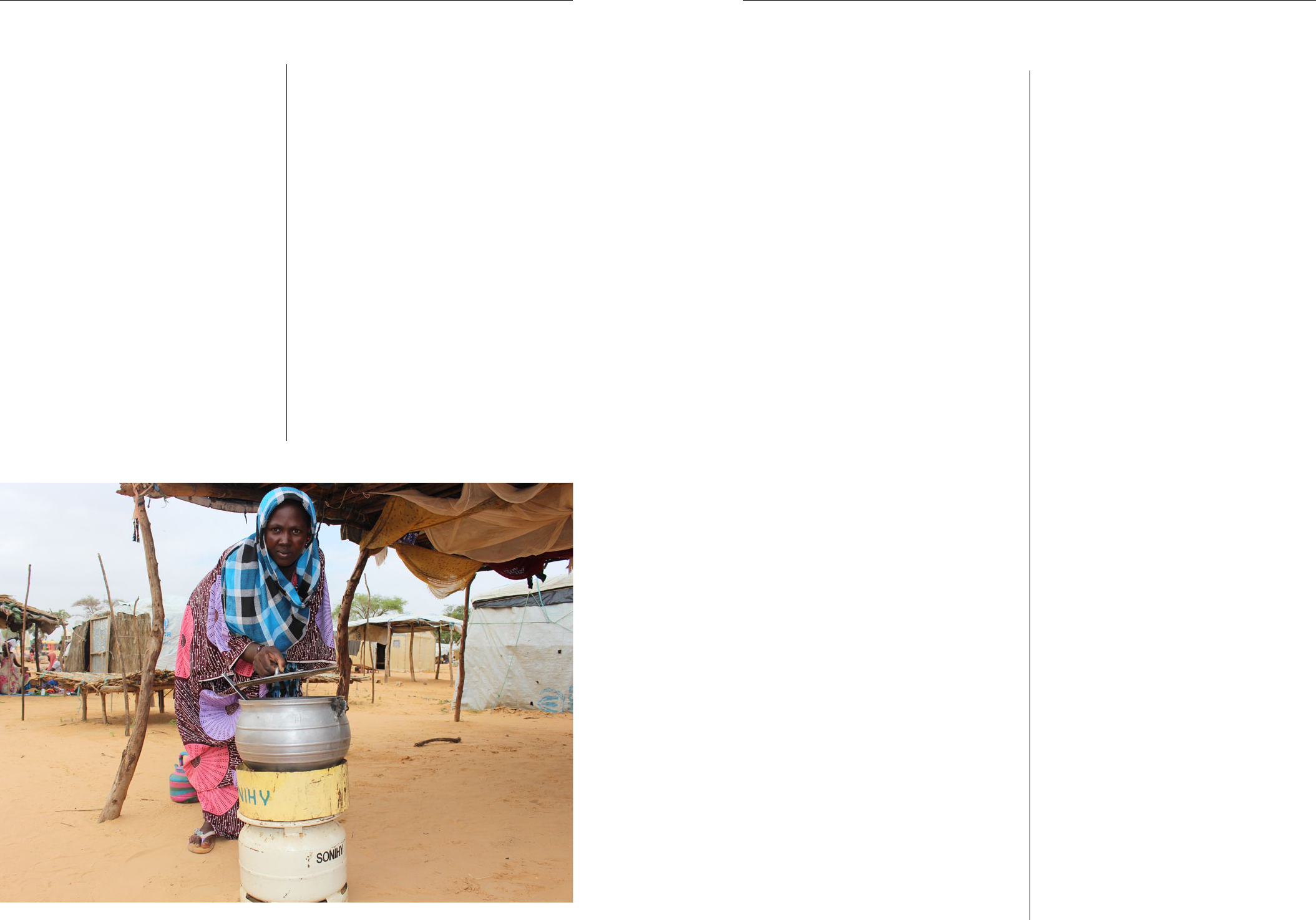
Blended Finance Solutions for Clean Energy in Humanitarian and Displacement Settings
1514
4. Blended nance solutions for energy programming in displacement settings
4.1.4. Example project: Commercial
development of an LPG market by UNHCR
Niger
The United Nations High Commissioner for Refugees
(UNHCR) Niger, with approximately 2 million Euros
of funding from the European Union (EU), developed
the SEED programme (Soutien Energétique et
Environnemental dans la région de Diffa), with the
aim of supporting the commercial development of a
regional, self-sustaining LPG market for clean cooking.
The intervention was focussed on the Diffa region
of Niger, where the wider ecosystem is supportive of
blended nance solutions. The Niger government has
afforded refugees with the legal right to work, study,
move freely, access nance and open bank accounts.
In addition, the displaced are fully integrated into local
communities, which also include IDP.
Prior to the SEED programme, households were paying
up to 24 USD per month for rewood; their main source
of cooking energy. Although LPG was available and
cheaper, approximately 10 USD per month, households
could not transition to LPG as a cooking fuel, as the
cost of the LPG kit (rst cylinder, gas regulator and
cookstove) was too high. The cost of the LPG kit was
approximately 40 USD, around 80% of the maximum
monthly household income of 50 USD per month
(UNHCR, 2017).
The SEED programme used the EU funding to purchase
25,000 LPG kits and distribute them freely to the most
vulnerable families in Diffa, together with vouchers to
rell the 6-kg LPG cylinders eight times, enough for
an average-sized household to cook with LPG for ve
to six months. By distributing LPG kits to vulnerable
households, UNHCR unlocked the barrier to entry and
created a commercial demand for cooking fuel. The
commercial demand was met by SONIHY, a Nigerien
gas company. SONIHY also invested 1.5 million Euros
in the scheme to construct ve new 10-tonne lling
stations, to service 30 new LPG selling points across
the region. UNHCR Niger also acted as a reference to
support SONIHY’s negotiations with a local bank to
obtain loans for the required infrastructure (Patel &
Gross, 2019).
As a result of economies of scale, through the SEED
programme and SONIHY investment in infrastructure,
Figure 5: Women refugee in Abala (Tillabery). Photo copyright: UNHCR/Boubacar Younoussa Siddo
the price of LPG has fallen from approximately 10 USD
per 6-kg cylinder to 3 USD per cylinder. An average family
now pays between 3 USD and 5 USD per month on energy
to meet its cooking needs. This cost reduction has
improved the sustainability of the LPG market beyond
the initial UNHCR subsidy period, with 70 per cent of
the 25,000 UNHCR-supported households continuing to
purchase LPG after their initial vouchers had been used
up. The low price of LPG has also attracted between
4,000 and 5,000 new LPG customers in the region who
were not SEED beneciaries (UNHCR, 2017).
Sellers of rewood who were negatively affected by
the fuel-switching programme were compensated
through cash or redeployed into the LPG supply chain
by opening small retail shops or supporting the delivery
of LPG with donated donkeys and carts.
Within 15 months, the total amount of EU funding for
SEED was recovered in savings from fuel purchases
by people living in the region. This household income
boost also supports other donor investments in
livelihood-improvement activities (UNHCR, 2017).
A number of project-specic lessons learnt have been
documented, which include:
● The most vulnerable households struggled to pay
the 3 USD for a 6-kg cylinder rell but could have
beneted from a smaller 2.5-kg cylinder bottle.
● Many of the 30% of households that stopped using
LPG after the SEED programme rells ran out did
so because they were forced to sell their cylinders
to pay for food.
● Development of livelihood opportunities should be
undertaken in parallel to energy access projects
to increase cash ows and the purchasing power
of end-users to increase the sustainability of the
energy projects.
Publicly available information of the lessons from the
UNHCR / SONIHY partnership has not been identied,
although the relationship building between partners is
a key part of any successful blended nance solution.
It would also be of value to understand the medium to
long term impacts of the project.
4.1.5. Lessons learnt
Targeted funding, delivered at the right moment, can
sometimes unlock a commercially viable project that
has a long-term impact. Direct funding could also be
used to kickstart local market demand for certain
energy products or services (e.g. clean cooking fuels)
by overcoming the initial capital investment hurdle.
It is noted that the successful outcomes of the project
examples were supported by:
● Accurate and relevant data on energy demand and
market dynamics was available.
● There was a clear economic model to help support
the transition of an existing energy customer to a
cleaner energy solution.
● Strong government support, with regards to the
cooking project in Niger.
● Relevant skills were available to review the project’s
commercial viability and ensure the sustainability
of the energy intervention.
● Donors were willing to act outside of the box.
● Internal champions who believed in the projects
and can advocate for a new way of working.
While each of the projects is a one-off piecemeal
solution, the solutions could be replicable in similar
environments, especially the example associated
with decarbonising energy infrastructure. Although
the condentiality agreement between the parties
is a challenge to discussing the business case and
identifying possible improvements to the approach.
Based on the above, however, a specic fund aimed
at identifying and unlocking commercial barriers in
displacement settings would prepare the ground for
large scale interventions.
4.2. Technical assistance
4.2.1. What is it and how does it work?
Technical assistance is a mechanism that can attract
private nance to humanitarian energy projects by using
‘in-kind’ technical expertise or a ‘technical assistance
grant’ to address knowledge gaps. It can be directly
incorporated within a nance solution or operate as a
discrete service.
Technical assistance can take the form of advisory
and consulting services for project preparation. It can
also include operational assistance, skills training,
knowledge sharing, and other professional services,
such as legal, nancial or procurement assistance to
improve the business viability of the project and thus
enhance its investment performance (IDFC, 2019 and
OECD & WEF, 2015).
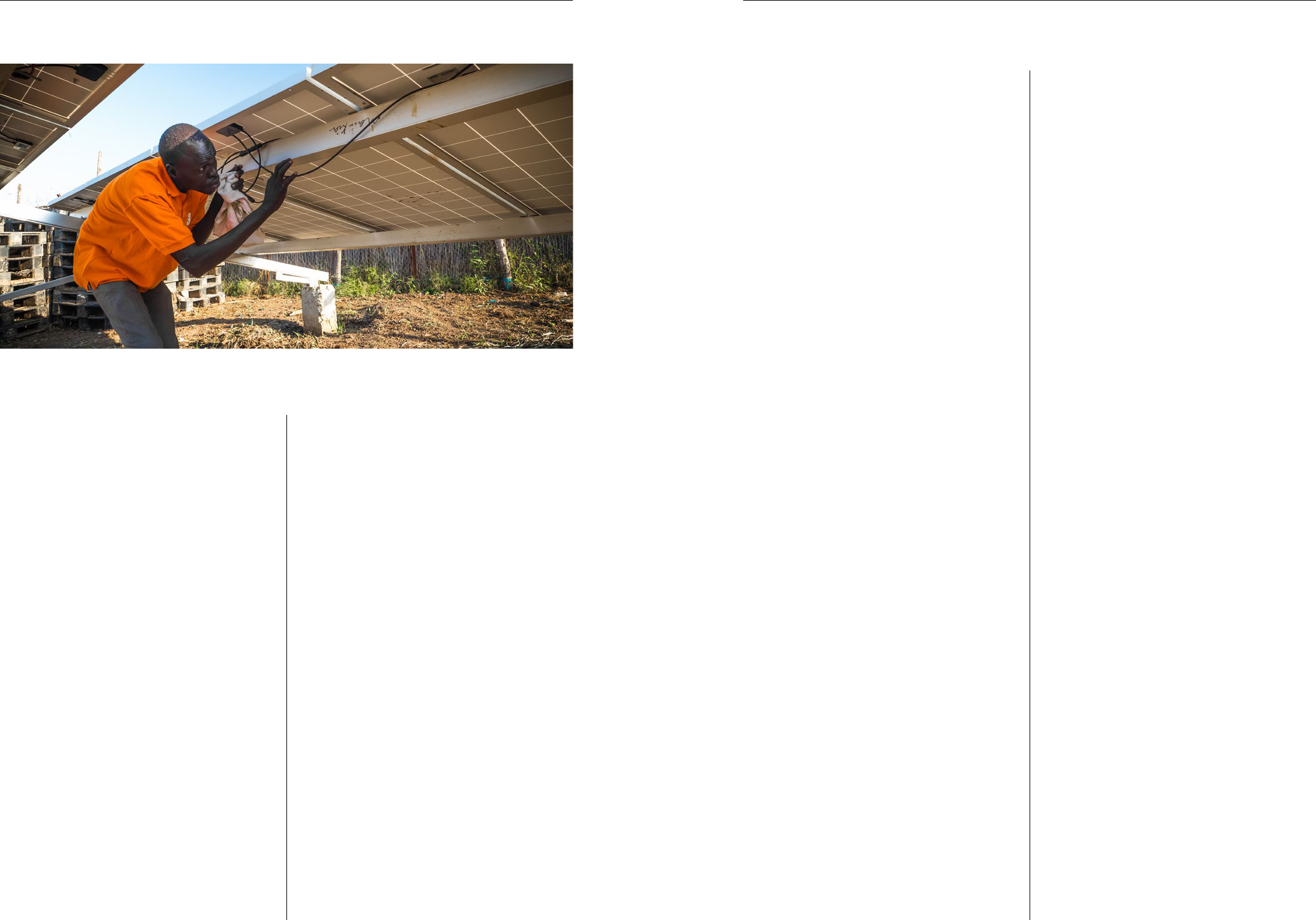
Blended Finance Solutions for Clean Energy in Humanitarian and Displacement Settings
1716
4. Blended nance solutions for energy programming in displacement settings
Technical assistance can only be considered a
blended nance mechanism if the outputs result in
a collaboration with the private sector to deliver an
energy solution.
4.2.2. How can it be applied to displaced
settings?
Expertise and capacity to design and implement modern
energy access and renewable energy interventions in
displacement settings are severely limited; as a result,
energy programmes have not been, and are not always
being, developed by energy specialists. Consequently,
it is rarely possible to get a clear understanding of
the energy needs of displaced communities, energy
programming is slow to adapt to new delivery models,
and there is limited understanding of the inputs and
supporting ecosystem required to move towards
sustainable private sector lead solutions. In addition,
internal support mechanisms tend to be most
responsive to energy programming that has gone on
before, which maintains the status quo.
Designing and implementing a modern energy solution
is complex, requires solid technical, economical
and implementation know-how, and can take up to
ve years to implement. Especially with regards to
undertaking baseline needs assessments and market
surveys, creating partnerships, developing sustainable
delivery models, balancing humanitarian needs against
commercial incentives and nding non-traditional
nancing. As a result, there is a need for energy
specialists across the project spectrum and throughout
the project lifecycle to undertake data collection,
interpret the data to establish the needs, develop
appropriate delivery models, support the creation of
business plans and nancial models, build project
partnerships, provide legal and procurement support,
implement projects, and monitor the results. Rarely can
one ‘expert’ undertake all these tasks, and rarely can
an specialist switch from delivering cooking projects to
developing a solar solution.
Humanitarian actors have, however, relied on
deployment programmes for years, where specialists
in a particular eld can be sent by a deployment agency
to support a humanitarian operation free of charge.
In addition, grants have also been used to pay for
specialist programming support. This can, however,
lead to procurement challenges if the initial support
has been provided by a commercial entity that could
also deliver the solution, as this would be dened as a
conict of interest under UN procurement rules.
4.2.3. Example project: NORCAP energy
expert deployment programme
NORCAPs clean energy project provides humanitarian
agencies with much needed energy expertise along
three strategic areas: improving energy access (cooking
and electrication) for end users; decarbonisation
of humanitarian responses through increased
renewable energy supply; and global coordination
through dedicated staff to the GPA Coordination Unit
and headquarters of humanitarian agencies. The
programme has been funded by the Norwegian Agency
Figure 6: Solar panel wires being checked by the local volunteer Michael Gatluak at the NRC oce in Mankien, South Sudan. Photo copyright: NORCAP/
Iban Colón
for Development Cooperation (NORAD) for four years
to the value of approximately 6,700,000 USD. The
programme is geographically focused on supporting
energy solutions in Africa, given the need and impact.
In 2021, NORCAP provided energy expertise to partners
such as UNHCR, IOM, the Norwegian Refugee Council
(NRC), the World Food Programme (WFP), and the
United Nations Institute for Training and Research
(UNITAR) / GPA Coordination Unit. The experts have a
wide range of experience and expertise in the areas of
bioenergy, solar energy, energy eciency, coordination
and cooking energy and work in several countries in
Africa, including Tanzania, Kenya, Uganda and South
Sudan, as well as Jordan and UN agency headquarters
in Geneva and Rome.
NORCAP energy Specialists have undertaken initial
research, data collection, developed proposals and/
or engaged with potential partners on 15 projects to
support private sector lead solutions in displacement
settings.
From its experience in providing energy expertise
to humanitarian partners, NORCAP has noted the
following:
● Humanitarian agencies do not always have the
nancial means to move a particular energy
programme forward once developed by the energy
specialist.
● Not all humanitarian partners are aware of the
benets associated with private sector lead energy
solutions, and it can take a signicant amount of
advocacy to convince partners to transition to new
delivery models.
● A number of NORCAP energy specialists have
taken the GPA Energy Delivery Models (EDM)
Training Programme in order to support the
development of new energy interventions. This has
led to the creation of private sector-lead energy
project proposals that may not otherwise have
been written.
4.2.4. Example project: GIZ Energy
Solutions for Displacement Settings
The Energy Solutions for Displacement Settings
(ESDS) project is one of four components of a global
programme sponsored by the German Federal Ministry
of Economic Cooperation and Development (BMZ) to
support UNHCR in the implementation of the Global
Compact on Refugees (GCR). The focus of ESDS is on
providing sustainable energy solutions to refugee and
host communities in Ethiopia, Kenya, and Uganda to
enhance self-reliance. The 12 million Euro programme
began in November 2018 and is funded until the end
of December 2022. It is understood that a project
extension, along with an additional funding request, is
presently being prepared.
ESDS activities are structured along with three
intervention areas, namely:
● Improving the Policy Framework by working with
policy makers to create the required framework to
implement the GCR and ensure sustainable energy
access for refugees and host communities at a
national, regional and district levels.
● Greening UNHCR Infrastructure, by providing
technical advice to UNHCR to support the
implementation of energy eciency measures
to reduce its diesel consumption and to help its
transition to solar based energy infrastructure via
market-based approaches.
● Improving market-based access to energy by
promoting markets for sustainable energy products
and services for refugee and host communities
in collaboration with UNHCR and private sector
actors (Energypedia, 2021).
The ESDS project team works towards these objectives,
in selected regions, in collaboration with UNHCR
and local and national authorities. ESDS has also
provided technical assistance to UNHCR to support the
nalisation of the technical designs and comparative
nancial modelling for all sites that are to be solarised
under the Green Finance Facility (see section 4.3.3). In
addition, ESDS designed a nancial model adapted to
UNHCR requirements regarding tariff setting and cost
comparison for its solarisation programme.
The project is ongoing, and a mid-term review is
presently being drafted. It is, however, noted that:
● ESDS Uganda is working with Results Based
Financing (RBF) schemes for improved cookstoves
and SHS. Two stove companies and two solar
companies have been contracted, with 2,000 stoves
and 3,750 solar PV systems sold so far (numbers
are currently being veried independently). A
similar RBF scheme is planned for Ethiopia.
● A key learning from the RBF programme is that
although it enhances access to quality products,
the scheme can lead to conict with local
traders who are selling poor quality (sometimes
counterfeit) products.
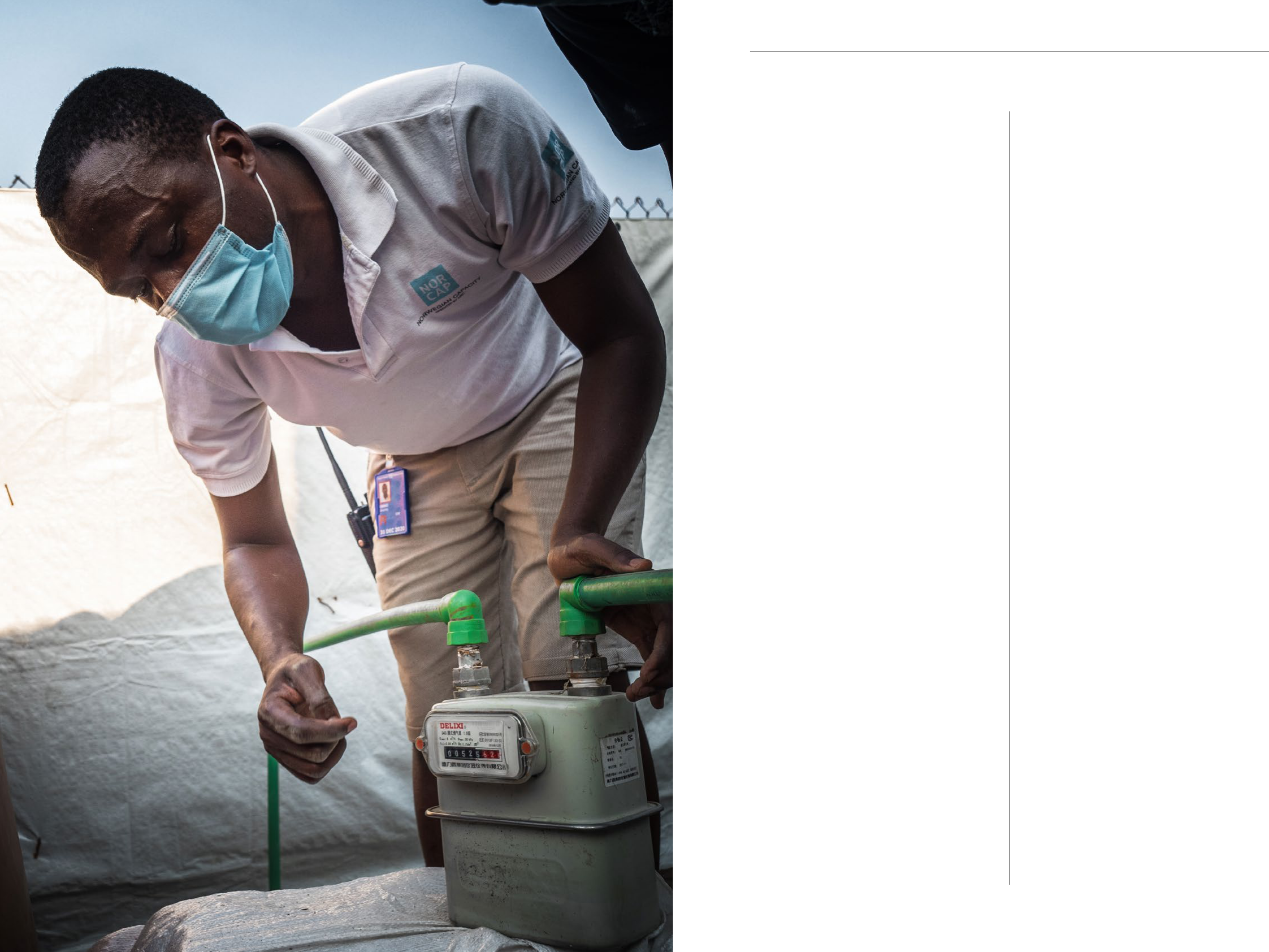
19
4. Blended nance solutions for energy programming in displacement settings
18
● The programme is only focused on one
humanitarian actor and working in three East
African countries, and, as a result, a structure
dissemination plan for the lessons learnt from the
various programmes and contexts would be of
value to the wider community.
● The technical capacity programme also comes
with its own project funding to support market-
based interventions, which brings additionality to
the programme.
4.2.5. Lessons Learnt
The provision of technical support is probably the
easiest blended nance solution to develop with
humanitarian actors. The results of which can lead to
improved project performance and, therefore, enhanced
investment opportunities.
There are, however, a few important considerations to
use this solution successfully:
● The receiving partner should provide a conducive
support structure (such as technical and personal
support or travel budget for the expert).
● Clear goals and deliverables should be identied
before the deployment with a commitment to apply
them.
● Community engagement, government support and
accountability need to be incorporated into the
project development process to identify the best
solution for a particular context.
● The receiving partner should consider developing
its own energy team at a regional or country level
and reducing the reliance on deployed, short-term
expertise.
● Exchanging knowledge and sharing data are
essential to avoid duplicating efforts and partners
working in the same context should join forces to
complement each other, not compete.
● At the global level, key partners join forces to create
standardised tools that help collect comparable,
quality data based on an agreed set of indicators.
Studies and exploratory work can be undertaken by a third
party, ensuring the independence of the conclusion and
removing potential conicts of interest with a potential
service provider. During long term deployments, which
include a knowledge transfer component, provide an
opportunity to increase local capacity and local knowledge.
4.3. Risk transfer mechanisms
4.3.1. What are they and how do they work?
Risk transfer mechanisms are management tools that
transfer risks to a third party. They involve one party
assuming the liabilities and nancial consequences
of another party, ensuring that any nancing gap that
might emerge is partially or fully covered (Economic and
Social Commission for Asia and the Pacic Committee
on Disaster Risk Reduction, 2017).
Risk transfer mechanisms can either: improve the
credit prole of energy projects or companies who are
seeking project capital; or provide comfort to investors
that they will be able to recover their investment or
absorb smaller losses if events negatively impact their
returns. Therefore, risk transfer instruments shift the
risk-return prole of an investment opportunity, moving
it from un-investable to investable. Two of the most
common types of risk transfer tools are insurance
policies and guarantees (IDFC, 2019).
Insurance policies are contracts issued by a third party
agreeing to make a payment in the case of a particular
event occurring, thus preserving the capital of the
insured party. In this way, they can reduce actual or
perceived risks.
A guarantee is a formal assurance that if an undesirable
event occurs, the guarantor will act on behalf of the
guaranteed party and assumes responsibility. For
example, a guarantee can be used to ensure that if an
individual fails to repay the costs associated with a
solar home system (SHS), the guarantor will cover all
or part of the repayment. Guarantees can help ensure
that commercial entities receive a minimum level of
return or can limit an investor’s losses if a business
opportunity underperforms.
More specically, a guarantee fund is money that has
been set aside and earmarked to underwrite a project
and acts as a formal assurance to the guaranteed party,
in this case the energy solution provider, see Figure 7. As
such, a guarantee fund provides direct compensation
to, or assumes losses for, a specied negative event
and in doing so offsets a nancial risk associated to
an energy intervention, which in turn facilitates private
capital investment.
For example, a loan guarantee is a nancial instrument
aimed at facilitating micro, small and medium-sized
enterprises’ access to formal lending through the
provision of credit guarantees that mitigate the risk of
non-repayment. In practice, a loan guarantee replaces
or reduces the need for other forms of collateral,
resulting in a larger number of enterprises having
The NORCAP expert Geophrey Oyugi
checking the levels of pressure at the
Biogas plant in Malakal – South Sudan.
Photo: NORCAP / Iban Colón
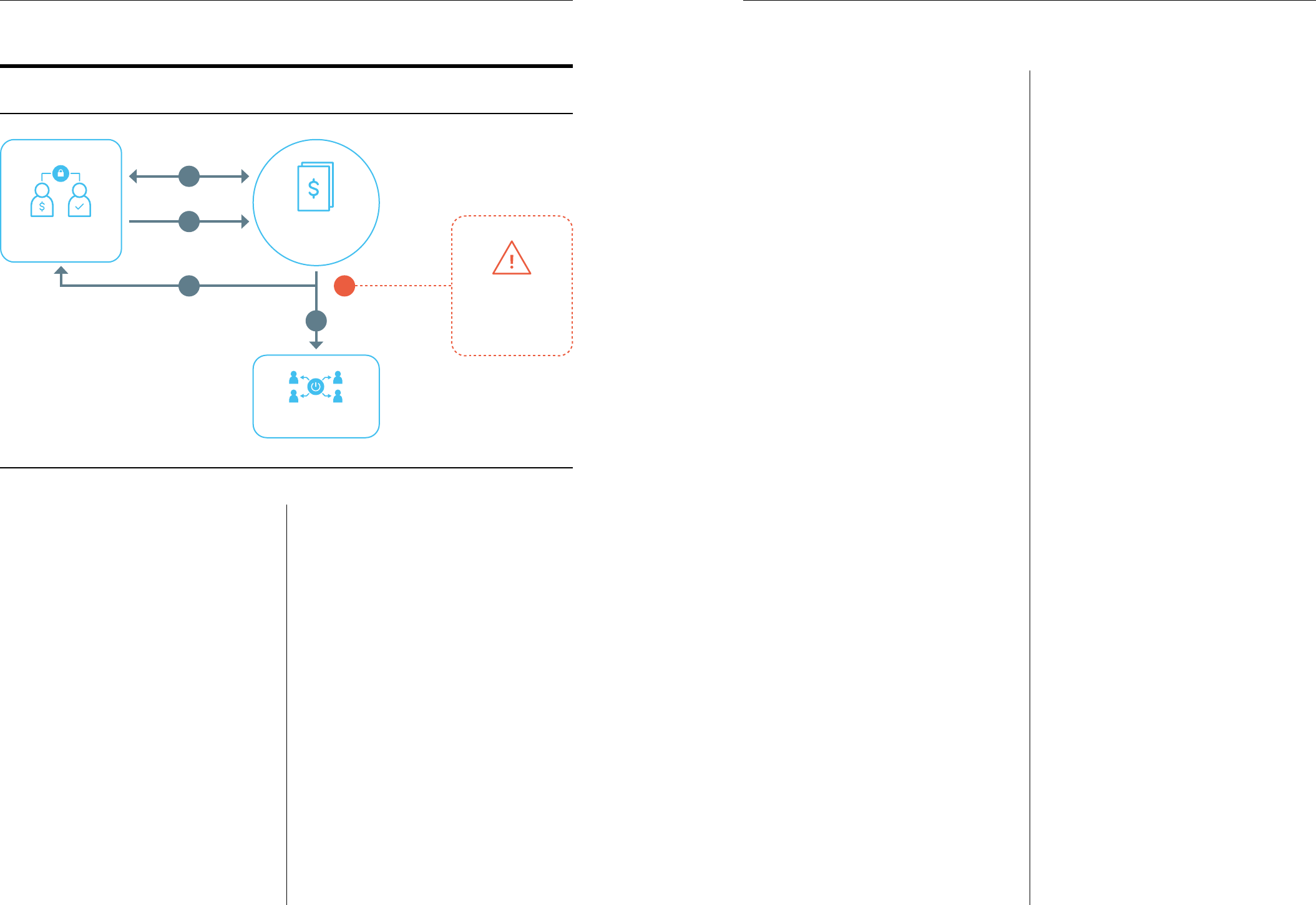
Blended Finance Solutions for Clean Energy in Humanitarian and Displacement Settings
2120
4. Blended nance solutions for energy programming in displacement settings
access to loan facilities. Essentially, a loan guarantee
is a commitment by a third party to cover all or some of
the risks associated with a loan to its client, who may
not have sucient collateral or may not be deemed
creditworthy. As such, if for any reason the borrower
fails to repay, the lender can resort to partial repayment
from the guarantor. Therefore, the loan guarantee
removes barriers to nancing the borrower and permits
nancing on more favourable terms. In addition,
loan guarantees can be used by commercially viable
enterprises but face additional barriers to nancing
(IFAD, 2014).
Insurance policies and guarantees typically require no
immediate outlay of capital, but payment is triggered
when a specied event occurs, which will only happen
in a small proportion of cases. This enables a given pot
of guaranteed funding to be spread across multiple
projects (WEF & OECD, 2015).
4.3.2. How can it be applied to displaced
settings?
In addition to the SHS example noted above,
humanitarian actors, especially within the United
Nations, must include termination clauses within
long term agreements, given the nature of their work.
The termination clause may give the supplier as little
as 30 days’ notice that the humanitarian actor is
intending to cancel the contract. Where the supplier
requires upfront investment to deliver the requested
services, such as constructing a solar system to
supply electricity to a humanitarian agency under a
power purchase agreement, the termination clause is
seen as a signicant contractual risk. As such, it may
be impossible or uneconomic for the energy supply
company to secure nancing for the upfront costs
associated with the solar system, even if the contract
is for a 10-year period. A guarantee underwriting the
termination risk within a contract could therefore
unlock private sector investment in solar solutions for
humanitarian actors.
Similar contractual risks may exist with other electricity
off-takers in displacement settings, such as health
centres, schools and/or commercial entities supporting
livelihood opportunities, which could be de-risked
through guarantees.
A loan guarantee could, for example, reduce the cost of
the goods as a result of reducing the cost of nancing.
This could be signicant, as the cost of nancing has
been identied as a major reason for the rise in costs to
the consumer for a pay-as-you-go solar home system
when compared to the costs associated with buying
the same system up front in a single payment. This
cost differential can result in PAYG SHS costing three
times as much when compared to an outright purchase
of the same system.
In addition, guarantee mechanisms could also be used
to secure loans to individuals in displacement settings
to pay for energy products in instalments (or via
PAYG models) to transfer excessive risk or to support
displaced and host community run energy projects.
On the other hand, there has been little use of risk
underwriting and insurance products as a blended
nance mechanism in displacement settings. The
anticipated high cost of such risk mitigation tools may
limit their role in the future.
4.3.3. Example project: UNHCR Green
Finance Facility
UNHCR’s compounds, premises, and oces generate
greenhouse gas emissions amounting to approximately
97,000 tons of carbon dioxide annually (UNHCR, 2020).
Diesel generators for the production of electricity are a
major source of these emissions. In 2019, the Swedish
International Development Cooperation Agency (Sida)
commissioned a study showing that converting diesel-
based infrastructure to solar energy could signicantly
reduce carbon emissions and costs. As a result, Sida
provided UNHCR with approximately 4 million USD to
establish an internal Green Finance Facility to support
its transition from diesel to solar energy.
The Green Finance Facility will be used as a guarantee
mechanism to de-risk contracts with the private sector,
providing clean energy as a service via long-term power
purchase agreements, which will:
● Allow UNHCR to leverage the technical and
nancing capabilities of the private sector to
undertake the design, ownership, operations, and
maintenance of the solar system.
● Support open and competitive procurement to
encourage fair and effective competition while
seeking the best possible technical solution.
● Support a termination payment in the event that
UNHCR has to terminate the contract(s) before the
end of the payback period.
● Reduce carbon generation at facilities by 60 to
100%, reduce costs by up to 35% and create
commercially viable opportunities for the private
sector in humanitarian settings (UNHCR, 2020).
UNHCR are initially targeting 3 sites; Kakuma in
Kenya and Adjumani and Yumbe in Uganda, following
an expression of interest, which closed in early
2021. The Request for Proposal was issued at the
beginning of September 2021 and will be directed to
preferred bidders who have been identied through the
expressions of interest process.
As the projects have yet to be established under the
Green Finance Facility, there is little to share with
regards to lessons learned, however, it is noted that:
● UNHCR’s energy transition programme, under
the Green Finance Facility and its energy access
programmes, is currently limited to their own
premises (oces). A solution suitable for
energy programmes in displaced or local host
communities (for example, using UNHCR or other
humanitarian agencies as an anchor client) still
needs to be developed.
● Financial guarantee mechanisms within the UN
system must follow UN nancial rules. With the
exception of the International Fund for Agricultural
Development and the United Nations Capital
Development Fund, reportedly, nancial guarantee
mechanisms within the UN are only permitted
when cash reserves match the nancial exposure
dollar to dollar, i.e., the value of the guarantee fund
must match the value of the guaranteed services
(UNDP Global Energy & Finance Advisor, 2020,
personal conversation; UNCDF Investment Lead,
2021, personal conversation).
● The Green Finance Facility is for one agency. Other
agencies have set up similar funds in the past for
other purposes. The existence of multiple funds
across multiple agencies can lead to competition
for donor funding. It would be more resource-
ecient if such a guarantee fund could be accessed
by multiple partners, including organisations
outside the UN.
● In relation to the previous two bullet points, a
global guarantee mechanism has been explored
by the GPA Coordination Unit. The results of the
study suggest a guarantee facility housed outside
of the UN, accessible by all, with 6 million USD of
capitalisation could underwrite 65 million USD
of private investment. This equates to 1 USD
of guarantee underwriting just under 11 USD of
investment (EMRC, Shell & GPA, 2020).
Figure 7: Overview of Guarantee Fund
Commercially
Viable Project
End Users
Guarantor
Potential negative
event or risk that
inhibits a commercially
viable project
Selling goods
and services
Independently veried
underperformance
Guarantee
Agreement
Payment based on
underperformance
1
4
2
!3
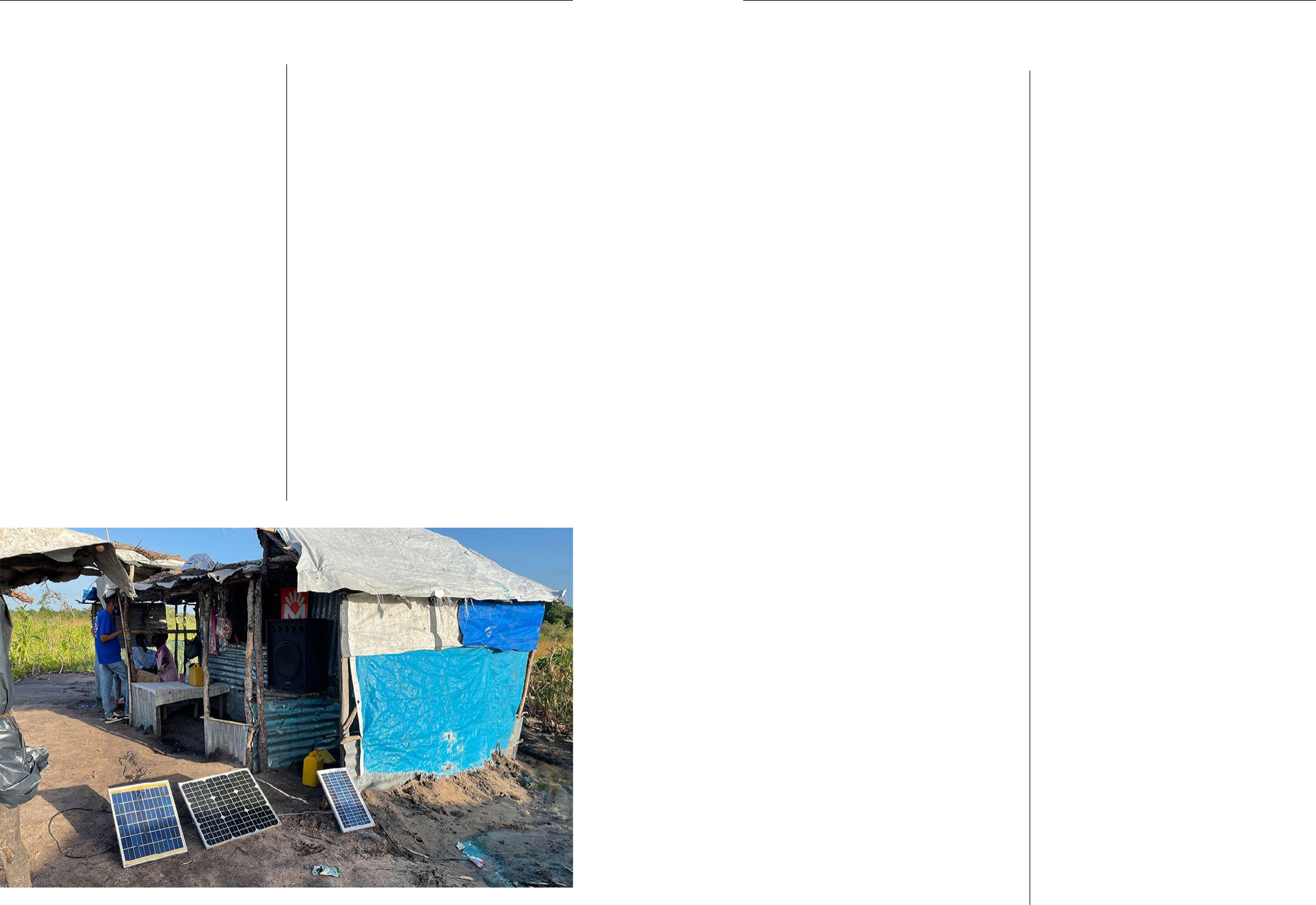
Blended Finance Solutions for Clean Energy in Humanitarian and Displacement Settings
2322
4. Blended nance solutions for energy programming in displacement settings
4.3.4. Example project: IOM Research in
Mozambique
In 2020 as part of Shell’s Enter Energy project and its
partnership with IOM, a consulting study done by the
Differ Group assessed the feasibility of setting up a
guarantee fund to support local Distributed Energy
Service Companies (DESCOs) that sell household
energy access products such as solar home systems
(SHS) to customers in displacement affected areas
in Mozambique. The study’s main objective was to
understand whether a particular guarantee mechanism
could overcome the following barriers: uncertainty
regarding the permanence of resettlement areas;
limited DESCO presence in resettlement areas; sparsely
populated rural and resettlement areas; high working
capital requirements for the DESCOs; and high capital
cost of productive use equipment which makes it risky
to sell on PAYG (Differ, 2021). The key ndings of the
study are noted in the proceeding paragraphs.
For instance, a product default guarantee mechanism
would compensate the DESCO for a pre-agreed share
of their nancial losses in the event where a customer
stops paying for a PAYG product during the repayment
phase (e.g. after three months of non-payment, and
lasting up to six months), also preventing the need
for product repossession. While this mechanism
would give such customers increased time to restart
their payments, which might help those with seasonal
revenues bridge to the next harvest season and avoid
repossession of the system, it also creates a strong
perverse incentive for customers to simply stop
making their monthly payments while continuing to use
their SHS. This would result in a very high likelihood of
rapid depletion of funds. Furthermore, the measuring,
reporting and verication (MRV) of this scheme would
be very challenging in practice as it would require
checking that the product was installed, that payments
were not made for the past three months, that support
was not already claimed for the device and that once
the guarantee support is provided, that the DESCO
would not be double compensated in the event that the
customer resumes making payments.
Lack of working capital was identied by some DESCOs
as a barrier to entering the SHS market in resettlement
areas. A working capital loan guarantee mechanism
could be used to create a fund, through the help of a
nancial institution/ intermediary to provide a credit
backstop in the event that DESCO defaults on their
working capital loan to their creditor. This scheme
has a much lower risk of being abused due to adverse
incentives and has a low likelihood of resulting in
depletion of funds.
A portfolio guarantee mechanism is similar to the
product default guarantee in that it absorbs a portion of
Figure 8: Energy assessment conducted by IOM Energy Ocers in a resettlement site in Sofala Province, Mozambique. Photo copyright: IOM 2020 /
Isaac Mwang
the risk of high customer defaults in resettlement areas.
It is, however, applied at the portfolio level, meaning
that it compensates a DESCO for nancial losses if the
average default rate on its entire pool of customers
exceeds the average default rate that it would
normally experience in a given country and covers this
difference. The result should be that the companies can
operate under the assumption that resettlement areas
perform the same way as the rest of the country and
are a normal part of the business. In terms of adverse
incentives, the scheme could potentially incentivize
DESCOs to sell to anyone regardless of income or ability
to pay, not follow up with delinquent accounts, and then
harvest the guarantee support in lieu of revenue. As a
consequence, there is a risk of fund depletion, which is
higher early on, and then diminishes over time.
The minimum income guarantee mechanism is
envisioned to support the sale or leasing of productive
uses equipment, which are usually outside the scope of
PAYG schemes due to their high capital costs and risks
of default. A minimum income guarantee could be used
to supplement customer repayments (which could
uctuate depending on seasonality or other factors)
and ensure that the DESCOs stay above the minimum
threshold of commercial viability in terms of income.
A return and default results-based framework
incentivises the return and repossession of unutilized
equipment, which could lower costs of defaults for the
DESCOs and make their operations more sustainable.
The scheme could help to create an ecient
secondary market for refurbished systems no longer
in use, while also potentially creating local employment
opportunities and kickstarting a circular economy
focused on the recycling of used systems. The scheme
would give already non-paying customers an incentive
to return (and received a deposit back) instead of
keeping unused equipment, especially if they are no
able to manage the payments. Less stranded assets
and electronic waste is an additional positive impact of
this mechanism.
4.3.5. Lessons Learnt
Risk transfer mechanisms can make energy projects
commercially viable in humanitarian settings by shifting
the risk-return ratio and reducing the cost of capital.
Risk transfer mechanisms can be tailored to address
specic problematic risks for a given type of project,
ensure funds are channelled to where they are
most needed, thereby unlocking a hurdle preventing
private sector engagement. In addition, a single local,
regional, national, or global guarantee can enable the
development of more than one project.
Guarantee mechanisms can, however, generate moral
hazards and adverse incentives that must be considered
in the project’s design, implementation, and MRV
phases. The biggest adverse incentives are: non-paying
customers having little incentive to resume payments;
over-incentivising product repossessions (where
DESCOs rush to seek compensation for delinquent
contracts); trouble targeting the right populations (e.g.
IDP versus host community); underreporting successes
(especially where system sales data are not used as
a baseline); repeatedly reporting the same defaults;
and overstating the level of defaults in the case of
portfolio approaches. These adverse incentives can be
partially counter-balanced by effective MRV programs.
In practice, however, MRV is also costly and presents
its own challenges in terms of ensuring 100 percent
accuracy of results.
In general, guarantee mechanisms are fairly complex
and require signicant time and investment to set
up, with engagement from multiple stakeholders to
ensure a context-appropriate design and prudent
implementation strategy. If, however, structured and
administered well, they do have the opportunity to
remove specic barriers or risks from the market
and attract new market participants to otherwise
underserved areas.
Loan guarantees lower the risk of lending to small
businesses. However, the primary constraint at the
lender level is the lack of relevant products, trained
staff, and an outreach strategy, which can result in a
block to accessing credit.
Though quite effective for high-risk situations,
insurance mechanisms can be expensive and may not
therefore be applicable or appropriate for all situations.
4.4. Market incentives
4.4.1. What are they and how do they work?
Market incentives aim to support investment with
high-impact outcomes in situations where normal
market conditions do not exist, for instance, in a
refugee settlement. In doing so, they look to create
commercial markets where they did not originally
exist by encouraging capital to move into areas
with humanitarian and/or development needs. Such
incentives are particularly important to markets
that require innovative solutions to deliver impactful
products and services.
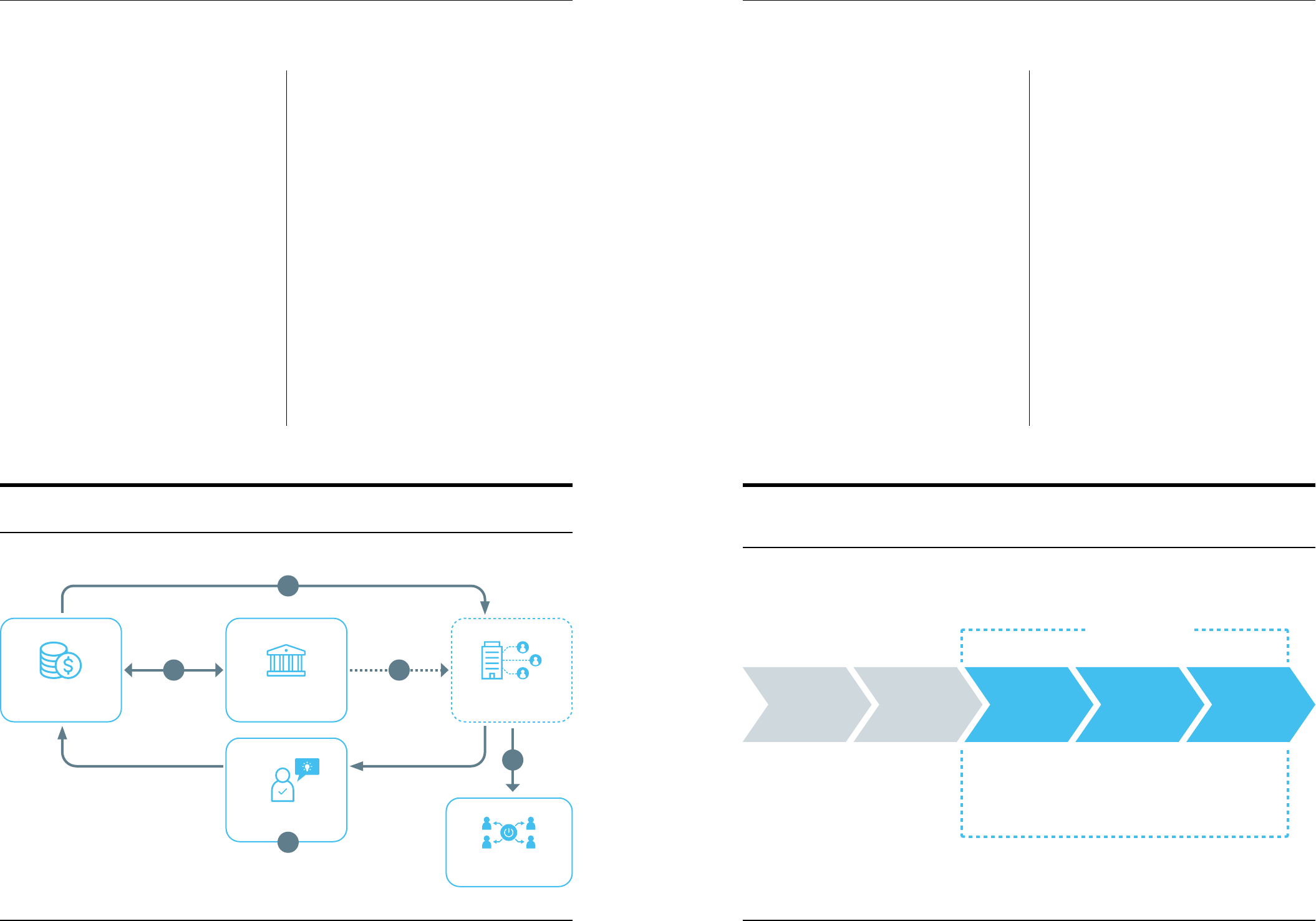
Blended Finance Solutions for Clean Energy in Humanitarian and Displacement Settings
2524
4. Blended nance solutions for energy programming in displacement settings
Market incentives are generally structured as a
guarantee for payments against products and services
based on performance or supply, or in exchange for
upfront investment in new or distressed markets.
Examples include Results Based Financing (RBF),
impact bonds and challenge funds, among others. The
following sections provide an overview and examples
of RBF, impact bonds and challenge funds.
4.4.2. Results Based Financing
WHAT IS IT AND HOW DOES IT WORK?
Results Based Financing (RBF), commonly referred to
as ‘payment by results’ is an umbrella term referring to
any program or intervention that provides rewards to
individuals or institutions after agreed-upon results are
achieved and veried (World Bank, 2019).
RBF involves three key principles. Firstly, payments
are made only after the results have been achieved.
Secondly, the recipient may independently choose how
to achieve these results. And lastly, an independent
verication of the results triggers the agreed nancial
disbursements (Sida, 2015). The rationale behind
this approach is to directly link nancing with outputs
and outcomes rather than inputs and processes. The
objective is to increase accountability and create
incentives for service providers to improve programme
effectiveness and achieve agreed results while
providing the service providers with the autonomy
and exibility to adjust their project implementation
strategies to deliver the most impact (OECD, 2014).
Therefore, results-based approaches shift the nancial
risk associated with the non-delivery of results from the
donor to the recipient of the funding.
RBF schemes begin with a contractual agreement
between a funder (donor) and an implementing
organisation who both agree on the outputs, outcomes
and impacts that are desired. The implementing party
either launches the program or intervention themselves
or invites third party service providers to participate
in the delivery of the solutions. Once the results are
veried by an independent body, the payment or
incentive is released by the funder to the the service
provider(s) as noted in the contractual agreement. A
pictorial overview of RBF is presented in Figure 9.
In contrast to traditional funding approaches, RBF
can drive innovation that leads to greater impact for
beneciaries and lowers the costs for funders (GPRBA,
2020). It is also regarded as being a reliable nancing
mechanism once its purpose has been clearly dened.
There are many different approaches to RBF, including
output-based aid, outcomes-based aid, and impact
bonds. Impact bonds are discussed in more detail in
the following section. Output-based aid is a nancial
mechanism that aims to increasing access to products,
goods and services that result in changes relevant to
the desired output. It is used in situations where people
are being excluded from basic services because
they cannot afford to pay the full cost of a service or
associated connection fees. Outcome-based nancing
includes mechanisms that tie funding to metrics more
closely related to the ultimate development objective,
i.e., ‘outcomes’ as opposed to intermediary results,
such as system actions, inputs, activities, and outputs.
Figure 10 provides an overview of the triggers for RBF
nancing.
HOW CAN IT BE APPLIED TO DISPLACED
SETTINGS?
Output-based aid could be used to target displaced
household connections to a solar mini-grid or increase
sales of clean cookstoves within a displacement
setting. While outcome-based nancing could be tied
to humanitarian programmes that reduce the amount
of greenhouse gasses, upscale and replicate new
business models or technologies, or reduce household
cost from shifts in spending on cooking fuels.
EXAMPLE PROJECT: SNV NETHERLANDS
Foundation of Netherlands Volunteers (SNV
Netherlands) is a non-prot international development
organisation that was among the rst organisations
to successfully implement RBF schemes to support
modern energy services in displacement settings and
for isolated off-grid communities.
In Mozambique, SNV is leading the implementation
of BRILHO – a ve-year programme started in 2019
to increase energy access. BRILHO’s main goal is to
improve energy access for both people and businesses
within the low-income population, leading to nancial
Results that trigger
disbursments
Financial and
human resources
used
Steps taken or
work performed to
transform inputs
into outputs
Products capital
goods and services
resulting in changes
relevant to outcome
Likely or achieved
short-term and
medium-term
effects
Long-term effects
produced
ImpactOutcomesOutputsActivitiesInputs
Figure 10: Overview of RBF Triggers
Adapted from OECD, 2014
Figure 9: Overview of Results Based Financing
End Users
Funder
Implementing Agency
Independent Verier
Service Provider(s)
Contractual
Agreement
Implementing
Agreement
1 2
Improved
Energy
Access
5
Payment for Results
Verication of Results
4
3

Blended Finance Solutions for Clean Energy in Humanitarian and Displacement Settings
2726
4. Blended nance solutions for energy programming in displacement settings
savings, better well-being and increased livelihood
opportunities. The program is targeting three product
segments: improved cooking solutions, SHS and mini-
grids and hopes to impact as many as 1.5 million
people. To reach this target, BRILHO works with
selected companies to provide a mix of catalytic grants
and RBF in order to reduce the risks associated with
providing energy solutions to low-income markets (e.g.,
default risk, etc.) and ensure an attractive commercial
return.
The BRILHO programme pays a participating company
a cash incentive of around 40% of the product cost
(base amount) for each sale of a designated energy
access product to a rural customer after submitting
proof of sale, which a third party usually veries. On top
of this base amount, BRILHO provides additional bonus
incentives for products that provide a higher tier of
energy access (based on the Energy Sector Management
Assistance Program Multi-tier framework), for sales in
underserved areas, or for sales of products intended
to be used for productive uses and income generation.
Underserved areas are categorized and ranked based
on a Vulnerability Access Index. By June 2021, BRILHO
had reached over 33,000 clients/households across the
country and supported the purchase of a SHS.
LESSONS LEARNT
RBF schemes can be very effective at incentivising
market participants to enter underserved areas such
as displacement settings by focusing attention on
the delivery of results, and by creating a conducive
environment for adaptation and experimentation.
Although they may be less effective than conventional
approaches if the recipient lacks the capacity, incentive,
or access to capital necessary to deliver the agreed
outputs or outcomes (ESMAP, 2015).
RBF can reduce the time and resources that
humanitarian partners spend monitoring processes and
checking that resources are being spent appropriately.
While the value of measuring outcomes may be
apparent, what is less clear is how to go about doing
it, as measuring outcomes is not easy. As a result,
greater expenditure may be required on independent
verication. In addition, in situations where there are
multiple incentive schemes available, there is a risk of
double-dipping or over-incentivising the market, leading
to adverse consequences such as manipulation and
fraudulent claims. It has, however, been argued that
RBF can reduce the risk of corruption, as money is only
disbursed when results are delivered.
While RBF addresses the supply side for energy
products and services in underserved markets, it does
not increase the affordability of products for bottom-
of-pyramid customers in displacement settings. In
order to mitigate this challenge, RBF should be bundled
with other mechanisms which can support the lowest-
income customers, such as loan guarantees, exible
payment terms, payment nancing, PAYG models, and
guarantee funds for defaulting accounts.
RBF programmes should also be combined with
minimum product standards and quality approval
policies to ensure that the products sold meet
international standards and do not create an adverse
incentive for the dumping of sub-par products onto low-
income markets.
4.4.3. Impact Bonds
WHAT IS IT AND HOW DOES IT WORK?
Impact bonds are outcomes-based contracts. They
use private funding from investors to cover the upfront
capital required for a provider to set up and deliver a
service. The service is designed to achieve measurable
outcomes specied by the commissioner. The investor
is repaid only if these outcomes are achieved.
Impact bonds bring together three key partners to
deliver better outcomes for a target group: the outcome
payer, the service provider, and the investor.
Social impact bonds (SIBs) refer to impact bonds in
which the outcome payer is the government which
represents the target group. Development impact
bonds (DIBs) refer to impact bonds in which the
outcome payer is an external donor - an aid agency of
a government or multilateral agency or a philanthropic
organisation (Global Outcomes Lab, 2021).
HOW CAN IT BE APPLIED TO DISPLACED
SETTINGS?
Impact bonds may not be best suited for conicts or
fast-moving crises as they can take too long to set up.
They could, however, support protracted humanitarian
situations, especially projects aimed at providing
infrastructure or delivering services, including those
associated with energy (New Humanitarian, 2019).
EXAMPLE PROJECT: ICRC’S HUMANITARIAN
IMPACT BOND
In 2017, the International Committee of the Red Cross
(ICRC) launched the rst “Humanitarian Impact Bond”
(HIB) with the goal of nancing the construction of three
new physical rehabilitation programme centres in Mali,
Nigeria, and the Democratic Republic of Congo. The HIB
mechanism allowed ICRC to mobilize 26 million Swiss
francs of social investments from the private sector to
support these rehabilitation programmes and directly
benet tens of thousands of persons with physical
disabilities due to conict within these three countries
(ICRC, 2017). The HIB is structured similarly to a loan
but with added incentives to drive positive outcomes
and penalties for poor performance.
The “Outcome Funders” comprised of the governments
of Switzerland, Belgium, Italy, the United Kingdom,
and the La Caixa Banking Foundation based in Spain.
They pledged to pay ICRC for the concrete results
achieved over a period of ve years. This impact
was measured using an output metric called Staff
Eciency Ratio (SER), which is calculated by the
number of beneciaries having regained mobility
thanks to a mobility device, divided by the number of
local rehabilitation professionals employed by the
centres. “Social Investors” initially loaned the ICRC
the money required for the project and comprised of
New Reinsurance Company (a subsidiary of Munich
Re), Lombard Odier pension fund, and several other
charitable foundations (Ecorys, undated).
At the end of the ve-year term, the Outcome Funders
pay ICRC, based on the results measured and impact
assessed. Using the funds received from the Outcome
Funders, ICRC then repays the Social Investors. In
the best-case scenario, if there is an 80% or greater
performance improvement in the SER ratio compared
to previous rehabilitation centres, the investors will
earn an annual return of 7.0% per year (34.5% over
ve years). In the worst-case scenario, the investors
can lose up to 11.3% per year (or 40% overall) if the
SER performance worsens relative to the benchmark
(Ecorys, undated).
LESSONS LEARNT
Impact bonds are relatively complicated when
compared to other nancing mechanisms. They take
time to develop, resulting in higher administrative costs
(Princeton University, 2014). They are, therefore, best
suited for multi-year, longer-term projects that can
contribute to achieving durable solutions. As soon
as the metrics have been established, however, and
awareness is raised, the costs of developing impact
bonds should reduce (UNDP, 2016). The model of
payment for success does, however, spare funders the
cost of failed programs.
In addition, impact bonds should be developed to
meet a specic need. In the case of the ICRC HIB, it
was rst decided to use a HIB, which then lead to the
development of the project.
There needs to be exibility in terms of understanding
of what an impact bond is. Not all components will
be applicable to all contexts and organisations.
Organisations take part in impact bonds for different
reasons, and the impact bond needs to be adapted with
this in mind. Investors do, however, want to be involved
earlier, so that they are able to feed into the design of
the terms and conditions of the IB.
It is unlikely to see many projects similar to the ICRC
as most organisations in the United Nations or typical
NGO’s are not allowed to enter into any nancial
agreements that are similar to a loan.
4.4.4. Enterprise Challenge Fund
WHAT IS IT AND HOW DOES IT WORK?
An enterprise challenge fund is a funding instrument
that operates by distributing grants (or concessional
nance) to prot-seeking projects on a competitive
basis (UNDP, 2016). The competition for funding is
usually focused on a broad sector, such as energy, to
solicit innovative proposals that may not otherwise be
discovered through more traditional grant-making or
funding mechanisms.
Such a fund supports private investment with a
measurable social and/or environmental outcome.
A challenge fund will typically utilise public sector or
private foundation funds for a competitive market-
based or incentive-driven solution. As such, enterprise
challenge funds help mitigate market risks, while
“challenging” the private sector to innovate for the
public good.
The grants (or concessional nance) are risk-sharing
subsidies since the private rm co-invests its own
resources. Challenge funds can thus leverage public
nancing to achieve better developmental outcomes,
while inuencing market behaviours through
demonstration and imitation effects. The latter is linked
to the promotion of sustainable and inclusive business
by inuencing the private sector to adopt business
models that respond to the needs of the poor (UNDP,
2016).
Three elements characterise challenge funds. Firstly,
the private sector drives the solution’s design, co-
nancing and implementation. Secondly, grant funding
is awarded through a competitive process. And lastly,
the “challenge” provides a broad development and
commercial focus that awards innovation.
Once capitalized, challenge funds operate through calls
for proposals, which are assessed competitively and
according to established criteria. Performance-based
grants or concessional nancing is offered to the best
proposals.
HOW CAN IT BE APPLIED TO DISPLACED
SETTINGS?
An enterprise challenge could be used in displacement
settings to engage the private sector in addressing the
challenges in such locations. In doing so, the results can
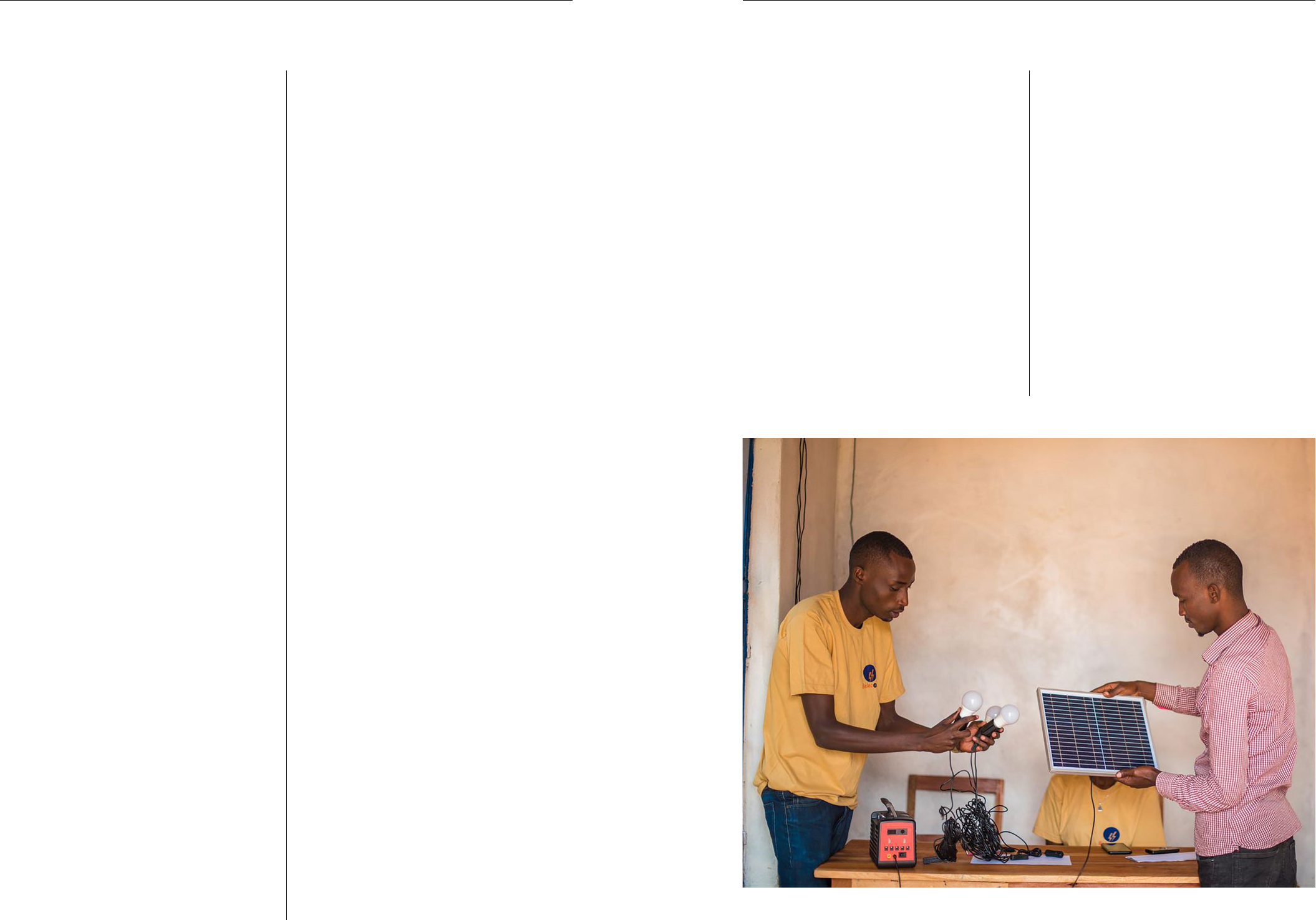
Blended Finance Solutions for Clean Energy in Humanitarian and Displacement Settings
2928
4. Blended nance solutions for energy programming in displacement settings
build the case for the private sector to lead solutions,
help identify, test, and scale solutions and advance
the humanitarian principles of humanity, neutrality,
impartiality and independence (Humanitarian Grand
Challenge, 2021).
EXAMPLE: HUMANITARIAN GRAND CHALLENGE
The Humanitarian Grand Challenge aims to provide
funding to “life-saving or life-improving innovations to
help the most vulnerable and hardest-to-reach people
impacted by humanitarian crises caused by conict.”
The funding is focused on innovative solutions that
provide, supply, or locally generate:
● Safe drinking water and sanitation;
● Energy;
● Life-saving information; or
● Health supplies and services.
Innovations could come from companies or not-for-
prot organisations and must include input from the
affected communities they seek to serve. Preference
will be given to locally-lead solutions to support people
living in areas with active conict, people who are
internally displaced by conict or refugees. In addition,
innovations that focus on people who are vulnerable in
conict-affected humanitarian crises will be prioritised,
such people who are particularly vulnerable due to their
gender, sexuality, religion, age, or income; people with
disabilities, chronic health conditions; as well as people
who are stateless, minorities, or unable to evacuate to
safety.
The Humanitarian Grand Challenge seeks out new
promising innovations and looks to support the scaling
of solutions that are proven to work. Achieving this
requires a holistic approach where critical barriers to
market growth and expansion are addressed.
The Humanitarian Grand Challenge is funded by the US
Agency for International Development, the UK Foreign,
Commonwealth & Development Oce, the Government
of the Netherlands Ministry of Foreign Affairs, and
Global Affairs Canada.
As of August 2021, 21.3 million USD has been invested
in 52 innovative solutions in 23 countries. There is no
specic breakdown of funding for energy projects under
the Humanitarian Grand Challenge. It was, however,
noted that the challenge fund had supported 11 proof of
concept energy projects in nine countries (DRC, Kenya,
Nigeria, South Sudan, Sudan, Syria, Turkey, Uganda, and
Yemen) and one scale-up energy project in DRC.
Over the past three years, the GPA Coordination Unit
has been involved in the review of applications for
energy. During this study, no documentation on lessons
learnt from funded energy projects were identied.
EXAMPLE: KAKUMA KALOBEYEI CHALLENGE
FUND
The Kakuma Kalobeyei Challenge Fund (KKCF) is a
program of the International Finance Corporation,
implemented by the Africa Enterprise Challenge Fund,
Turkana County Government, and UNHCR. From
October 2020 to September 2024, the ve-year program
is designed to support private sector investment and
unlock the economic potential of refugees and their
hosts, in Kenya’s Turkana County. The 25 million USD
initiative is supported by the:
● EU;
● Kreditanstalt für Wiederaufbau (KfW - German
Development Bank);
● Netherlands Ministry for Foreign Affairs;
● Swiss Agency for Development and Cooperation;
and
● UK Foreign, Commonwealth & Development Oce.
The KKCF aims to increase the economic integration
and self-reliance of displaced populations and the local
host community. The objectives of the initiative are to:
● Attract new private businesses and social
enterprises to the Kakuma-Kalobeyei area, which
should lead to better employment opportunities for
refugees and the host community, increase access
to goods and services, and potentially reduce
prices;
● Provide opportunities to scale-up the operations of
private companies and social enterprises already
present in the area;
● Develop and grow refugee and host community-
owned businesses and create opportunities for
women and youth; and
● Reduce the time and cost of obtaining specic
business permits, licenses, and registrations in
Turkana West by streamlining procedures (KKCF,
2021).
The challenge fund has been designed to inspire and
motivate businesses, social enterprises, and local
entrepreneurs to propose competitive and sustainable
solutions to meet the challenges people living in the
Kakuma and Kalobeyei areas are facing. By providing
seed capital for companies with strong potential for
growth, the fund hopes to de-risk the business concept,
attract commercial funders, and support its long-term
commercial viability. KKCF will address development
challenges around, amongst others, access to capital
and access to clean energy. Winners of the challenge
fund can access between 250,000 USD and 750,000
USD, although the lower limit is reduced to 100,000 USD
for projects run by women or youth.
Given the relatively new status of the project, there are
at present no lessons to share. The set-up of the fund is
very promising since it encourages long-term marked-
based solutions, which are necessary in protracted
crises. It would, however, be interesting to compare the
results of a global fund with those of a targeted local
fund.
LESSONS LEARNT
Enterprise challenge funds offer an effective means
to engage the private sector with minimal market
distortions. The results of which can be used to
inuence the behaviour of the private sector through
systemic innovations and demonstration effects,
as innovation is increasingly seen as an approach to
solving development and humanitarian challenges.
There is, however, a risk that innovative projects might
be chosen over less ground-breaking projects with
greater potential for impact (UNDP, 2016).
Usually, the proposals in a competitive process like a
challenge fund are reviewed by external evaluators.
They often have diverse backgrounds, have different
levels of experience, and what they consider as
‘innovative’ may vary a lot. It is therefore advisable
to invest time in exchanging views and ‘levelling’ the
experience of evaluators. Unfortunately, this is often an
underdeveloped component of the process.
Setting up a challenge fund does take up a signicant
amount of time and nancial resources and is not cost-
effective for a ‘one-off’ round.
Figure 11: The Belecom team demonstrate and support the installation of their solar home systems (SHS) in refugee camps in Rwanda. They
established community loan groups to promote nancial resilience and assure the poorest households can afford the SHS. Photo: Practical Action /
David Nkurunziza

Blended Finance Solutions for Clean Energy in Humanitarian and Displacement Settings
3130
4. Blended nance solutions for energy programming in displacement settings
Providing guidance, as taken from the GPA’s EDM
Training Programme, on what makes a good ‘proof
of concept’ and ‘scale up’ proposal could strengthen
applications.
4.5. Using more than one blended
nancing mechanism
It may not be possible to address all the barriers, risks
and market interventions associated with a particular
energy intervention with one blended nancing
solution. One or more blended nance mechanisms,
each targeted to a particular barrier, may be needed to
support private sector lead solutions. A good example
of this is the Renewable Energy for Refugees (RE4R)
SHS project in Rwanda.
4.5.1. Renewable Energy for Refugees
(RE4R) project
The RE4R project is a partnership between Practical
Action (PA) and the UNHCR in Rwanda, and NRC in
Jordan, funded by the IKEA Foundation. RE4R works
in urban settings in Jordan and camp settings in
Rwanda. The project aims to improve energy access
by strengthening and supporting commercial markets;
promoting economic activity for refugees and host
communities; providing ‘Total Energy Access’ by
targeting households, enterprises, and community
service providers; and fostering change at systems
level.
In Rwanda, RE4R partnered with two SHS suppliers,
Bboxx and Belecom, to provide SHS to households
in Gihembe, Kigeme, and Nyabiheke Refugee Camps.
Bboxx and Belecom provided two different business
models, products, and price points to address different
market segments in the refugee camps. Bboxx aimed
to reach households with mid to high levels of energy
spending through subsidised prices. Belecom targeted
households with mid-levels of energy spending by
offering a smaller and cheaper system, with the potential
to extend their business model to households with low
levels of energy spending through a revolving fund.
The revolving fund provides a group loan and savings
facility for its customers. This revolving fund allowed
participants to use loans to set up micro-enterprises
(e.g., vegetable selling, food stalls, clothes trading) to
boost household incomes and cover loan repayments
and SHS monthly fees when household incomes were
irregular. Cash-Based Interventions were in place in
all three camps before the programme started, but
cash for cooking fuel assistance was added in 2019
(Practical Action, 2021).
The SHS suppliers were supported by RE4R through a
mix of blended nance mechanisms, with examples
shown below.
● Direct funding to remove commercial barriers:
● RE4R provided direct nancial support to
Belecom for the construction of their shops
in the camps to reduce overheads that would
impact the costs of their systems, which were
aimed at households at the mid to lower end of
household energy spending.
● Technical assistance:
● Before engaging with the SHS suppliers,
RE4R conducted an extensive assessment
to gather data on the energy needs and
preferences of refugee communities, their
ability and willingness to pay, and existing
spending patterns, which was shared with SHS
suppliers during an Expression of the Interest
engagement process to help them develop
their offering. RE4R gathered data on what
refugees spent on a monthly basis on non-
renewable energy (batteries, candles, mobile
phone charging, etc). This was then split into
three bands of spending – higher, middle and
lower.
● RE4R also offered nancial and technical
assistance to address private sector
knowledge gaps in working in displacement
settings during the SHS supplier engagement
process.
● RE4R provided in-house staff training to sales
agents, technicians, and customer support
staff recruited from the refugee camps.
● RE4R also provided a technical assistance
grant to cover the costs of a consultant to
support the design and implementation of
Belecom’s revolving fund.
● Mitigating risks:
● Belecom products were aimed at lower-
income households, many of which were
subject to uctuating income, often as a
result of seasonal work. Belecom therefore
was concerned about the risk of non-payment
during lean nancial periods and, as such,
developed a revolving loan and savings facility
for its customers. The RE4R project provided
the seed capital for the revolving fund after
successfully completing a pilot.
● Market incentives:
● The Bboxx system was considered to be
beyond the spending levels of the “high” market
segment and therefore the cost of their system
was identied as the main barrier to entering
the market in the camps. As such, payments
were made to Bboxx to subsidise the cost of
their SHS.
● Tranches of RBF were also released to Bboxx
and Belecom based on them achieving pre-
agreed milestones associated with their
market development activities.
RESULTS
At the end of June 2021, 3,644 SHS were sold and
installed in the three refugee camps in Rwanda
through the RE4R project. The total amount of the
blended nancial mechanisms provided were weighted
according to the market segments and sales targets
each supplier aimed to reach. As a result of the project,
customers observed improvements in their quality
of life through domestic, livelihood and recreational
activities and were able to maintain regular payments
for the SHS. Bboxx has remained operational after PA
funding ceased, providing after-sales support to its
customers in the camps and more widely in Rwanda.
Bboxx has released a smaller capacity, cheaper SHS to
the market. Belecom sales are still ongoing and are in
the transitioning phase with promising signs that the
intervention will be sustainable once blended nancing
is no longer available.
LESSONS LEARNT
The business models of these suppliers, however,
struggled to reach certain market segments due to the
cost of the SHS and other barriers particular to certain
vulnerable groups, including those households with
the least income, the elderly, people with disabilities,
and those unable to work. It was also noted that the
refugee-wide cash-based intervention has supported
the purchasing power of the households and has been a
critical factor in the business models of both suppliers.
The next phase of the project aims to ensure the
sustainability of the SHS market in the long-term while
considering additional, targeted support to reach more
vulnerable groups, and provide advice and advocacy
on market-based approaches for renewable energy
solutions to the national government private sector and
other humanitarian stakeholders.
Based on the lessons learnt, Practical Action has
suggested the following future improvements to the
programme:
● Restructuring the subsidies so that they can be
targeted towards lower-income households.
● Balancing payment milestones across business
model activities to incentivise longer-term
commitments and continued customer satisfaction,
such as repair rates and the management of late
payments. The initial results-based element of
the programme was weighted towards managing
the early project costs borne by the private sector
partners.
● Working with the private sector partners with
regards to building trust so that they can share
commercial information with the funding partner
and help unlock what level and type of funding
are needed to better balance nancial risks,
private sector investment and funding support in a
transparent way.
● Ensuring the funder and the private sector partner
have a shared vision for the future of the market
and their business model after the funding ends.
This includes a shared understanding that the
funding is not a grant in the traditional sense but a
partnership to deliver sustainable energy solutions
in challenging markets, using blended nance
mechanisms to address specic barriers for the
context.

Blended Finance Solutions for Clean Energy in Humanitarian and Displacement Settings
3332
5. Conclusions, recommendations and next steps
5.1. Conclusions
With the possible exception for the provision of
technical assistance, there is limited experience in
using blended nance mechanisms to deliver SDG7
in displacement settings. Where there is experience,
it tends to have a narrow geographic focus, be project
driven, time-bound and limited to a handful of actors
and therefore, the underlying system and principles that
perpetuate the dominance of traditional grant funding
remain. As such, where blended nance solutions have
been deemed to be successful, they have not resulted
in replication or scaling up in a manner that delivers
sustainable solutions in neighbouring displacement
settings, in other countries and/or through other
humanitarian partners.
Nonetheless, there is a growing interest from private
sector entities and nancial institutions who see
opportunities in participating in the energy transition
and access initiatives as well as the emerging bottom-
of-the-pyramid consumer markets for energy solutions.
Although examples of blended nance mechanisms in
displacement settings that can provide crucial insights
are emerging, more data and objective evaluation is
needed if the risks and returns are to be appraised
fully and future mechanisms structured appropriately
(Cohen & Patel, 2019). There also appears to be a
collective resistance to sharing results and business
models publicly. This could be related to condentiality
agreements with private sector partners or with the
simple fact that the results were no more cost-effective
than a traditional approach. As a result, there is limited
ability to compare the economic effects of the various
instruments and to draw specic conclusions from
the use of blended nance solutions in displacement
settings, other than they provide a possible solution
to the existing funding gap. The humanitarian sector
would greatly benet from greater transparency and
sharing of data and lessons learned as new blended
nance approaches are piloted and evaluated.
There does, however, appear to be an opportunity
to partner with and leverage the experience of
development actors delivering energy solutions through
blended nance mechanisms to last mile, vulnerable
and underserved customers, such as the United
Nations Development Programme, the Organisation
for Economic Co-operation and Development, World
Economic Forum, and Energising Development. It
is noted that typical ‘development’ focused energy
projects no longer rely on grant-only models, there are,
however, fundamental differences between the two
sectors, including end-users in displacement settings
not always having the ability to earn an income.
5.1.1. High-level lessons learned
Some high-level lessons have been identied from this
study and wider knowledge of the topic, which include:
● Poor communication and coordination can lead to
the free distribution of goods and services by well-
meaning partners, which undermines the market-
based approach being developed by another
partner in the same displacement setting.
● There is a need for more to inform both policies
and programming and to identify contexts where
blended nance can play a lead role in delivering
solutions or accessing new sources of funds.
Concerted data collection and dissemination
can also lead to better coordination amongst
stakeholders.
● Change starts with the people. The humanitarian
system has limited expertise with respect to both
energy and nance. Historically, energy specialists
were often focused on the technical aspects of
project development, while using innovative nance
models requires a deeper understanding of nance
mechanisms and commercial modelling. Both
skillsets will be needed to build internal capacity
and deliver results.
● There are a limited number of blended nance
solutions that specically target the humanitarian
sector, although there may be the potential to
extend or adapt existing development focused
solutions to displacement settings.
5. Conclusions, recommendations
and next steps
● Combining more than one blended nance
mechanism to address the various commercial
barriers and risks that exist within a particular
market system may be appropriate.
● Cash-based interventions – and by association,
the right to work and access to nancial services,
banking facilities and mobile payment platforms
– have an important role to play in bolstering the
supporting ecosystem that the blended nance
mechanisms are intended to work in.
● The humanitarian and private sectors (including
nancing institutions) have historically operated
within two very different contexts. As a
consequence, they communicate, and view risks
and opportunities very differently.
● It can be dicult to balance concessional nancing
against private investment, given commercial
condentialities associated with individual
business models.
● Some traditional humanitarian donors can only
provide traditional grants at present. Many are
also working with output-based success indicators
(such as the number of people served), which may
be a risky approach for implementing partners. As,
at present, new innovative nance mechanisms
remain largely untested with regards to their
impact on the end-user.
● It is important to re-iterate that many innovative
nance solutions are based on a model where
the end-user is – at least partially – paying for the
new product or service. Given that the displaced
people are generally the poorest of the poor, these
solutions do have their limitations.
5.2. Recommendations
5.2.1. Developing blended nance solutions
Given the limited experience in humanitarian settings,
there is a need to test and develop blended nance
solutions through pilots and proof of concepts, with a
strong focus on scaling up the mechanism once proven,
and sharing knowledge and lessons learnt to a wide
audience of stakeholders who can support and respond
in similar contexts, including development actors. This
will require a broader set of skilled specialists and
increased project, process, and nancial transparency,
with a priority on independent verication, to ensure the
associated challenges at each stage of the project are
understood and the anticipated results are achieved.
The aim of the exercise would be to co-create, share and
continuously improve the most promising approaches
to blended nance in humanitarian settings and to
highlight potential pitfalls to minimise repeated failures.
Such an approach could be supported by donors, as a
condition of their nancial support.
5.2.2. More than Money
Due to the range of challenges associated with
displacement settings, the strategic mobilisation
of nancing alone may not be enough to deliver
sustainable energy solutions for such contexts. For
any blended nance mechanism to prove successful,
it is necessary to ensure cross-sectoral and industry
involvement to maximise potential impact (Cohen &
Patel, 2019). Consideration should therefore also be
given to:
● Developing new energy delivery models and
business models to take advantage of blended
nance opportunities, incorporating lessons
learnt from other sectors within the humanitarian
response, such as those already developed by the
Water, Sanitation and Hygiene (WASH) Sector.
● Improving the understanding of data needs,
collection and interpretation with regards
to developing blended nance solutions in
displacement settings.
● The project proponent engaging the private sector
early in the process to help develop blended nance
solutions, especially with actors already working in
the development sector or focused on delivering
impact, which would also support the creation of
a business and investment climate in a protection
focused environment.
● Promoting an inclusive and participatory approach
to the design and implementation of blended
nancing solutions, especially ones pertaining to
energy access projects, where all stakeholders
(including direct beneciaries) can be engaged
in the process and share vested ownership in the
outcomes.
● Tailoring successful blended nance solutions to
the local context, such as community needs and
priorities, socio-cultural and ecological practices,
and the domestic energy markets.
● Leveraging the lessons learnt and results from the
deployment of market-based solutions within middle
and higher-income households in displacement
settings to target bottom of pyramid customers.

Blended Finance Solutions for Clean Energy in Humanitarian and Displacement Settings
3534
5. Conclusions, recommendations and next steps
● Creating an enabling environment in a displacement
setting that would support the development of a
self-sustaining, private-sector-lead energy solution.
This may require:
● Policy interventions, such as supporting
a displaced population’s right to work or
enabling a clear regulatory environment at the
national level that could foster private sector
condence for commercial investment in
displacement settings; and/or
● Technical interventions, such as the
development of mobile phone connectivity
infrastructure to support the saving and
transfer of money through mobile phone
applications.
● Coordinating funders to reduce the potential for a
fragmented response through global, multi-donor
initiatives that would also benet the desire to
share experiences and lessons learnt.
● Educating humanitarian actors and private sector
partners on the opportunities and shared benets
of using blended nance solutions and expected
roles/contributions of each partner (i.e., it is not a
grant but a risk-sharing mechanism).
● Focusing on effective partnering as blended nance
solutions are based on collaboration, effective
communication, trust and reliable partnerships
across a diverse set of stakeholders.
● Developing a common working language and
a shared approach to designing solutions that
respects and includes the best aspects of both
humanitarian and private sector approaches.
5.2.3. Additional skills, training and
capacity building
Given the complexity associated with developing
nancial tools that transfer risk or provide market
incentives, additional nancial, legal, and commercial
skills will be required on top of the existing need for
energy specialists. Such skilled individuals may,
however, have limited understanding or knowledge
of humanitarian settings and may require some form
of ‘humanitarian induction training’. As noted above,
humanitarian actors can also benet from closer
collaboration and partnership with development actors,
who have many years of relevant experience and often
launch new projects and programs in adjacent markets
and geographies, sometimes using blended nancing
approaches.
To increase technical capacity to deliver blended
nance solutions for energy in displacement settings,
specialist deployment programmes, such as NORCAP,
should consider increasing the scope of their technical
advisory services. In doing so they could offer a
comprehensive blended nance service that not
only includes energy specialists but also provides
technical support for the nancial, legal, economic and
verication aspects of such projects.
In addition, existing energy specialists should be
provided with training to increase their understanding
of nancial mechanisms, so that they can provide
increased levels of support to projects that have an
innovative nancing component, including blended
nance.
it is also important to build the capacity of the donor
community, who would eventually be funding these
new instruments. This could be accomplished, for
example, through a webinar series or other dedicated
training sessions.
5.2.4. Ensuring inclusion of local solutions
Care should also be taken to ensure the additional
complexity of blended nance solutions does not
result in local solutions being excluded, including those
managed by the displaced communities.
5.3. Next Steps
5.3.1. Establishing a GPA task force on
blended nance
The GPA Coordination Unit will continue to evaluate
nancial instruments and, where practical to do so,
establish and coordinate a blended nance task force,
comprising key actors with experience in delivering
blended nance solutions and partners who have an
interest and senior management buy-in to develop
such solutions. The Task Force would include donors,
UN agencies, NGO’s, private sector representatives,
nancial institutions, NORCAP experts and end-users of
energy products and services (i.e., displaced and host
community members). The principal aim of the Task
Force would be to co-design, forge project partnerships
(humanitarian actor, funders, private companies and
relevant government departments), seek funding for,
implement, verify and share the results of pathnder
blended nance projects that could be scaled up to
meet the needs in neighbouring displacement settings,
in other countries and/or through other humanitarian or
private sector partners.
A key component of the Task Force would be to
help create and reinforce commercial markets in
displacement settings by developing de-risking and
market incentives that demonstrate commercial viability
with minimum use of concessional funds, i.e., developing
solutions that balance concessional nancing against
private investment. Consideration would also be given
to identifying good practices that support the demand
side of a sustainable energy market, e.g., cash-based
interventions, the right to work, etc.
In addition, the Task Force could assess the need to
develop global blended nance solutions in delivering
sustainable energy solutions in displacement settings.
And, where appropriate to do so, co-design and seek
funding for those solutions.
Similarly, given that energy is a cross-sectoral issue,
the GPA Coordination Unit will collaborate with other
humanitarian sectors that are currently looking into
blended nancing approaches, such as the WASH
sector. Learnings could be shared, and, where relevant,
common blended nance solutions could be used to
improve access to basic services (not limited to energy)
for the displaced populations and decarbonisation of
humanitarian infrastructure.
The outputs and ndings from the Task Force and
from other blended nance projects, including those
associated with challenge funds, would be promoted
by the GPA and NORCAP networks through workshops
and webinars to share knowledge and lessons learnt.
The aim of the workshops and webinars would be to
increase the uptake of blended nance mechanism,
highlighting common pitfalls, sharing experiences,
methodologies and proformas with a view to
continuously improving the approaches to deliver
the expected impacts. Furthermore, the Task Force
could help to identify and champion new opportunities
to pilot blended nance solutions for the benet of
the wider community. It is also anticipated that an
ongoing learning process, sharing of good practices
and dialogue on potential pilot projects could lead to
improved cooperation and transparency, which are
essential at this time.
5.3.2. Developing a GPA/NORCAP toolbox
As a rst step to supporting energy practitioners
develop blended nance solutions, the authors and
NORCAP energy specialists will co-develop a toolbox.
The toolbox would provide high level guidance on the
topic and include a summary matrix showing which
blended nance mechanisms are most suitable for
different types of energy projects.
5.3.3. Further studies on building a
supporting ecosystem
It is recommended that a study focused on supporting
the demand side of energy projects is undertaken.
This study should focus on the role and experience
of developing a ‘supporting ecosystem.’ It should,
therefore, look at the role of livelihood programmes;
cash-based interventions; access to nance and
banking facilities; government policies on the right to
work, freedom of movement, registration to support
bank accounts, energy contracts, mobile phone
contracts; infrastructure (mobile phone masts), etc.
on market-based energy solutions. The ndings of the
study would be incorporated into the toolbox to provide
additional support to energy practitioners.

Blended Finance Solutions for Clean Energy in Humanitarian and Displacement Settings
3736
Works cited and consulted
Bisaga, I., & To, L. S. (2021). Funding and Delivery Models
for Modern Energy Cooking Services in Displacement
Settings: A Review. Energies, 14(4176).
Chatham House. (2021). Beyond the UN: Closing the
Humanitarian Funding Gap. www.chathamhouse.
org/2021/07/beyond-un-closing-humanitarian-funding-
gap
Cohen, Y., & Patel, L. (2019). Innovative Financing for
Humanitarian Energy Interventions. Chatham House
Paper, February, 50. www.chathamhouse.org/sites/
default/les/2019-02-2019-InnovativeFinancingforHu
manitarianEnergy.pdf
Development, R., & Initiative, F. (2016). Blended Finance in the
Private Sector Context.
Differ. (2021). Design of an Energy Guarantee Fund - Final
Report: Targeting increased uptake of PAYG energy
equipment in resettlement areas of Mozambique.
Dubey, S., Adovor, E., Rysankova, D., Portale, E., & Koo, B.
(2019). Kenya: Beyond Connections: Energy Access
Diagnostic Report Based on the Multi-Tier Framework.
doi.org/10.1596/24368
Economic and Social Commission for Asia and the
Pacic Committee on Disaster Risk Reduction.
(2017). Economic and Social Council. In The Oxford
Handbook on the United Nations. doi.org/10.1093/
oxfordhb/9780199560103.003.0007
Ecorys. (undated). ICRC Humanitarian Impact Bond for
Physical Rehabilitation. s3.eu-west-2.amazonaws.
com/golab.prod/documents/ICRC_Programme_for_
Humanitarian_Impact_Investment.pdf
EnDev. (2020). Transforming energy access markets with
Results-based Financing.
Energy & Extractives Global Practice (ESMAP): The
International Bank for Reconstruction and Development.
(2020). Funding the Sun: New Paradigms for Financing
Off-Grid Solar Companies.
Energy Market and Regulatory Consultants Limited (EMRC).
(2020). Feasibility and Applicability of a Global Guarantee
Mechanism in Humanitarian Energy Contracts (Issue
September).
Energy MRC, Shell & GPA. (2020). Feasibility and Applicability
of a Global Guarantee Mechanism in Humanitarian Energy
Contracts. energypedia.info/images/5/57/Energy_
Provision_in_the_Humanitarian_Sector.pdf
Energy Sector Management Assistance Program (ESMAP).
(2015). Results-Based Aid in the Energy Sector: An
Analytical Guide. openknowledge.worldbank.org/
bitstream/handle/10986/21622/945670ESM0P1270
ergy0Sector0TR005015.pdf
Enerygpedia. (2021). GIZ Energy Solutions for Displacement
Settings. energypedia.info/wiki/Energy_Solutions_for_
Displacement_Settings
Global Impact Investing Network. (2021). The State of Impact
Measurement and Management Practice. thegiin.org/
assets/2017_GIIN_IMM%20Survey_Web_Final.pdf
Global Impact Investing Network. (2021). What You Need
To Know About Impact Investing. thegiin.org/impact-
investing/need-to-know/#what-is-impact-investing
Global Outcomes Lab. (2021). Impact Bonds. golab.bsg.
ox.ac.uk/the-basics/impact-bonds/
Global Partnership for Results-Based Approaches. (2020). An
Introduction to Outcome-Based Financing. www.gprba.
org/sites/gpoba/les/publication/downloads/2020-11/
GPRBA_Outcomes_Fund-Brochure-Final%5B19562%5D.
pdf
Global Platform for Action on Sustainable Energy Solutions
in Displacement Settings. (2019). The Global Plan of
Action for Sustainable Energy Solutions in Situations of
Displacement: Framework for Action. 1–64. www.unitar.
org/ptp/sustainable-energy
Global Platform for Action on Sustainable Energy Solutions
in Displacement Settings. (2021). Why is Energy
Important? www.humanitarianenergy.org/what-is-the-
gpa/why-energy-is-important/
Hamp, M., Rispoli, F., & Agwe, J. (2014). Lessons Learned:
Loan Guarantee Funds. doi.org/10.1111/lic3.12037
Haselip, J. (2021). Exploring the role of Liqueed Petroleum
Gas as a Clean Cooking Solution for Refugees and Host
Communities in Low-Income Countries (draft).
Humanitarian Grand Challenge. (2021). Creating Hope
in Conict: A Humanitarian Grand Challenge.
humanitariangrandchallenge.org/
International Bank for Reconstruction and Development,
& The World Bank. (2020). The International Finance
Corporation’s Blended Finance Operations: Findings from
a Cluster of Project Performance Assessment Reports.
www.worldbank.org
International Committee Of The Red Cross. (2017). The
world’s rst “Humanitarian Impact Bond” launched to
transform nancing of aid in conict-hit countries. www.
icrc.org/en/document/worlds-rst-humanitarian-
impact-bond-launched-transform-nancing-aid-
conict-hit
International Development Finance Club. (2019). Blended
Finance: A Brief Overview. www.idfc.org/wp-content/
uploads/2019/10/blended-nance-a-brief-overview-
october-2019_nal.pdf
International Finance Corporation. (2018). Blended Finance a
Stepping Stone to Creating Financial Markets. www.ifc.
org/wps/wcm/connect/8e7889db-2860-4ed3-a465-
54d1070ff2fb/EMCompass_Note_51-BlendedFinance_
FIN+April+13.pdf?MOD=AJPERES&CVID=mbkK6Id
International Fund for Agricultural Development.
(2014). Loan Guarantee Funds. www.ifad.
org/documents/38714170/40185546/
Loan+guarantee+funds.pdf/ef9500ef-f892-479d-8d8f-
50ebfb767a5c
International Organisation for Migration. (2020). The
Humanitarian Hub in Malakal, South Sudan Goes Green.
www.iom.int/news/humanitarian-hub-malakal-south-
sudan-goes-green
Investopedia. (2021). Denition of Subsidy. www.
investopedia.com/terms/s/subsidy.asp
Kakuma Kalobeyei Challenge Fund. (2021). Our Objectives.
kkcfke.org/our-objective/
Lahn, G., & Grafham, O. (2015). Heat, Light and Power for
Refugees Saving Lives, Reducing Costs. Chatham
House Report for the Moving Energy Initiative. www.
chathamhouse.org/sites/default/les/publications/
research/2015-11-17-heat-light-power-refugees-lahn-
grafham-nal.pdf
New Humanitarian. (2019). Saving lives and making money:
Can humanitarian impact bonds marry the two? www.
thenewhumanitarian.org/analysis/2019/08/15/
humanitarian-impact-bonds
Nordic Development Facility. (2016). African Guarantee Fund
Green Guarantee Facility Proposal for Final Consideration
(Issue June).
Organisation for Economic Co-operation and Development.
(2018). Technical Workshop on Results-Based Funding.
www.oecd.org/dac/peer-reviews/Results-based-
funding-workshop-Report.pdf
Organisation for Economic Co-operation and Development.
(2018). Blended Finance Funds and Facilities. www.oecd.
org/dac/nancing-sustainable-development/blended-
nance-principles/blendednancefundsandfacilities.
htm
Organisation for Economic Co-operation and
Development. (2020
1
). Blended Finance Principles
Guidance. www.oecd.org/ocialdocuments/
publicdisplaydocumentpdf/?cote=DCD/DAC(2020)42/
FINAL&docLanguage=En
Organisation for Economic Co-operation and Development.
(2020
2
). OECD DAC Blended Finance Principle 4: Focus
on Effective Partnering for Blended Finance.
Organisation for Economic Co-operation and Development.
(2021). The OECD DAC Blended Finance Guidance. doi.
org/10.1787/ded656b4-en
Patel, L., & Gross, K. (2019). Cooking in Displacement Settings
Engaging the Private Sector in Non-wood-based Fuel
Supply. www.chathamhouse.org/sites/default/les/
publications/2019-01-22-PatelGross2.pdf
Practical Action. (2021) Improving Energy Access for
Refugees in Rwanda: Working with the Private Sector.
infohub.practicalaction.org/handle/11283/622834
Princeton University. (2014). Social Impact Bonds A New Tool
for Social Financing. spia.princeton.edu/sites/default/
les/content/Social%20Impact%20Bonds%202014%20
Final%20Report.pdf
Refugee Investment Network. (2019). Kiva Refugee
Investment Fund. refugeeinvestments.org/
opportunities/kiva-refugee-investment-fund/
Rivoal, M., & Haselip, J. (2018). Delivering market-based
access to clean cooking fuel for displaced populations
the Kigoma region, Tanzania: a business plan. unepdtu.
org/publications/delivering-market-based-access-to-
clean-cooking-fuel-for-displaced-populations-the-
kigoma-region-tanzania-a-business-plan/

Blended Finance Solutions for Clean Energy in Humanitarian and Displacement Settings
38
Rockefeller Philanthropy Advisors. (2017). Impact Investing:
An introduction. www.rockpa.org/wp-content/
uploads/2017/10/RPA_PRM_Impact_Investing_Intro_
WEB.pdf
Rosenthal, G. (2009). Economic and Social Council.
The Oxford Handbook on the United Nations,
00907(August), 1–13. doi.org/10.1093/
oxfordhb/9780199560103.003.0007
Scatec Solar. (2020). Scatec Solar completes solar hybrid
plant for IOM in Malakal, South Sudan. scatec.
com/2020/06/05/scatec-solar-completes-solar-hybrid-
plant-for-iom-in-malakal-south-sudan/
Sida. (2015). Results Based Financing Approaches (RBFA) –
what are they? www.sida.se/publications
Shell, Dalberg & Vivid Economics. (2020). Access to
more: creating energy choices for refugees. www.
shell.com/sustainability/_jcr_content/par/text_
over_image_caro_395647644/text_over_image_
caro_237760834/buttonUrl.stream/1595953271615/
db4946328e61328b1001fd5534929aa47dfe3db6/
shell-enter-energy.pdf
SNV. (2021). BRILHO Homepage. brilhomoz.com/about-us
SNV. (undated). Catalysing off-grid energy market growth.
snv.org/assets/explore/download/snv_rbf_capability_
statement_a4_print_0.pdf
Stahel, W. R. (2012). OECD meeting Policy forum on
Adaptation to CC in OECD countries Session 1 : Risk
sharing and risk transfer (Issue May).
The Global Plan of Action for Sustainable Energy Solutions in
Situations of Displacement. (2019). The Global Plan of
Action for Sustainable Energy Solutions in Situations of
Displacement: Framework for Action. 1–64. www.unitar.
org/ptp/sustainable-energy
The International Bank for Reconstruction and Development.
(2014). Results-Based Financing for Clean Cookstoves in
Uganda (Issue April). www.worldbank.org
United Nations. (n.d.). UN Secretary-General’s Strategy
for Financing the 2030 Agenda. www.un.org/
sustainabledevelopment/sg-nance-strategy/
United Nations Capital Development Fund. (2016). Access
to Clean Energy for the Poor Through Micronance
(CleanStart).
United Nations Development Programme. (2016). Impact
Investment. doi.org/10.1057/9781137507273.0008
United Nations Development Programme. (2016). Social
Impact Bonds and Development Impact Bonds. www.
instiglio.org/en/sibs-worldwide/
United Nations Development Programme. (2016). Enterprise
Challenge Funds. www.undp.org/content/sdnance/en/
home/solutions/enterprise-challenge-fund.html
United Nations High Commissioner for Refugees. (2017).
Rapport Narratif Final: Soutien Energétique et
Environnemental à la Région de Diffa.
United Nations High Commissioner for Refugees. (2021).
2020 Global Report. www.unhcr.org/agship-reports/
globalreport/
United Nations Oce for the Coordination of Humanitarian
Affairs. (2021). Global Humanitarian Overview 2021.
gho.unocha.org/
Van Landeghem, L. (2016). Private Sector Engagement The
Key to Ecient, Effective Energy Access for Refugees
(Issue May).
Van Rooij, P., & Bastiaenen, M. (1997). Guarantee Funds and
NGOs : Promise and Pitfalls - A Review of the Key Issues
(Issue 18).
World Bank. (2019). Results Based Financing in Education:
Learning from What Works. documents1.worldbank.org/
curated/en/915061548222619389/pdf/Results-Based-
Financing-in-Education-Learning-from-What-Works.pdf
World Economic Forum. (2021). Calls for Private Investment
to Fill Humanitarian Aid Needs. www.weforum.org/
press/2021/01/calls-for-private-investment-to-ll-
humanitarian-aid-needs/
World Economic Forum, & Boston Consulting Group. (2019).
Humanitarian Investing - Mobilising Capital to Overcome
Fragility (Issue September). www3.weforum.org/docs/
WEF_Humanitarian_Investing_Initiative.pdf
World Economic Forum, & Organisation for Economic
Co-operation and Development. (2015). Blended
Finance Vol . 1 : A Primer for Development Finance
and Philanthropic Funder. In ReDesigning Development
Finance Initiative (Vol. 1). www3.weforum.org/docs/
WEF_Blended_Finance_A_Primer_Development_
Finance_Philanthropic_Funders_report_2015.pdf
World Economic Forum, Organisation for Economic Co-
operation and Development, & Deloitte Monitor. (2016).
Blended Finance in the Private Sector Context. In
ReDesigning Development Finance Initiative.
Authors and
acknowledgements
The authors would like to thank the following for input to, and/or feedback on, the
report, including provision of photographs:
● GIZ ESDS: Megan Taeuber;
● GPA Coordination Unit: Thomas Fohgrub, Aimee Jenks and Sadiq Zafrullah;
● IOM: Eva Mach, Anais Matthey-Junod (NORCAP Junior Energy Expert) and Isaac
Mwathi;
● NORCAP: Karina Fredly Sætre and Lama Gharaibeh;
● NORCAP Blended Finance Working Group: Teresa Le, Emmanuel Biririza, Borja
Gomez Rojo and Mustafa Almomani;
● Practical Action: Laura Clarke and Louise Rowen; and
● UNHCR: Benoit Moreno.
The authors of the report are:
Mark Gibson
NORCAP Energy Expert deployed to UNITAR /
GPA Coordination Unit
Adam Ostaszewski
NORCAP Energy Expert deployed to IOM
Cristina Simonetti-Techert
NORCAP Energy Expert deployed to UNITAR /
GPA Coordination Unit
Arielle Ben-Hur
UNITAR / GPA Coordination Unit
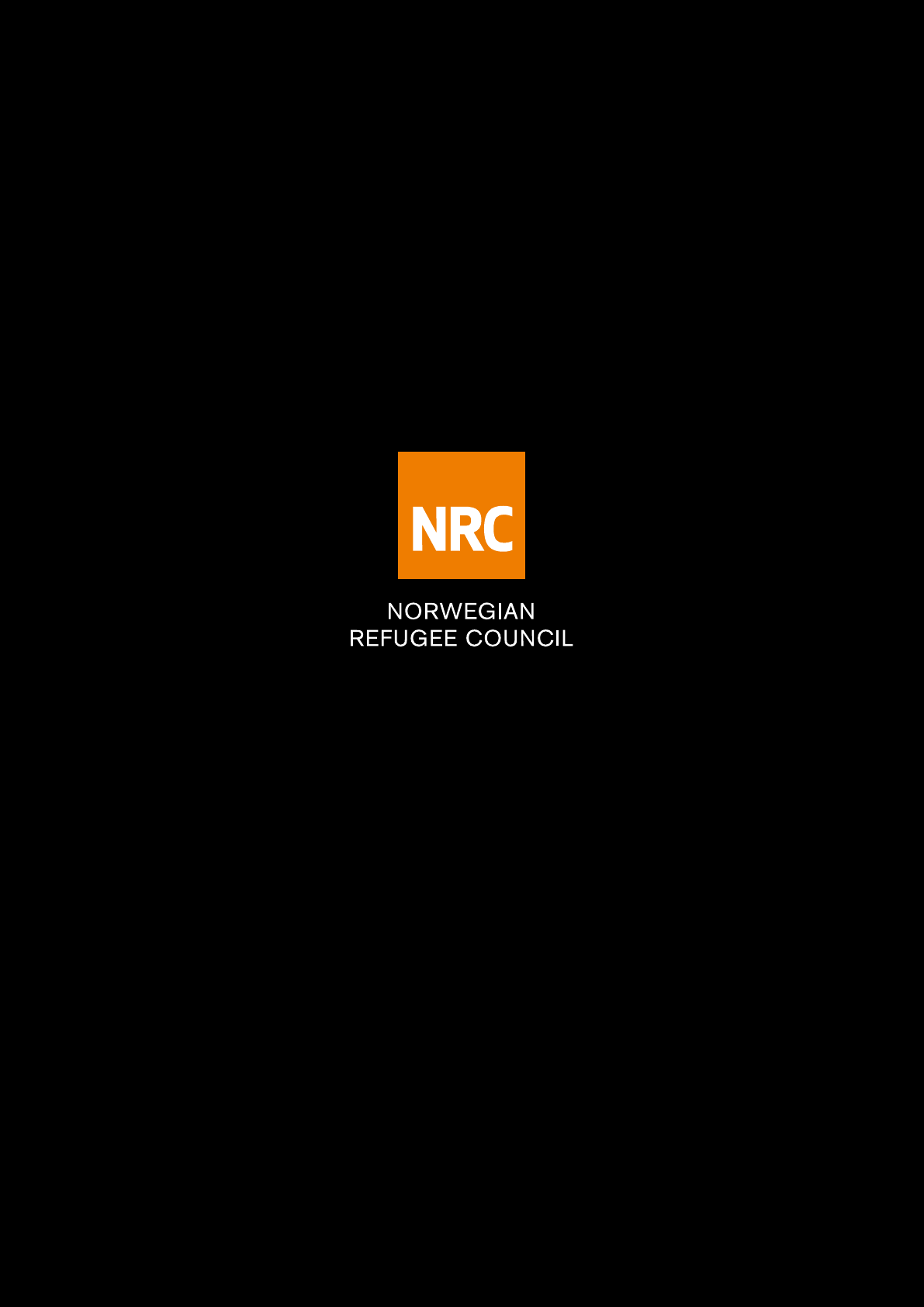
Norwegian Refugee Council
Prinsens gate 2
0152 Oslo Norway
www.nrc.no
